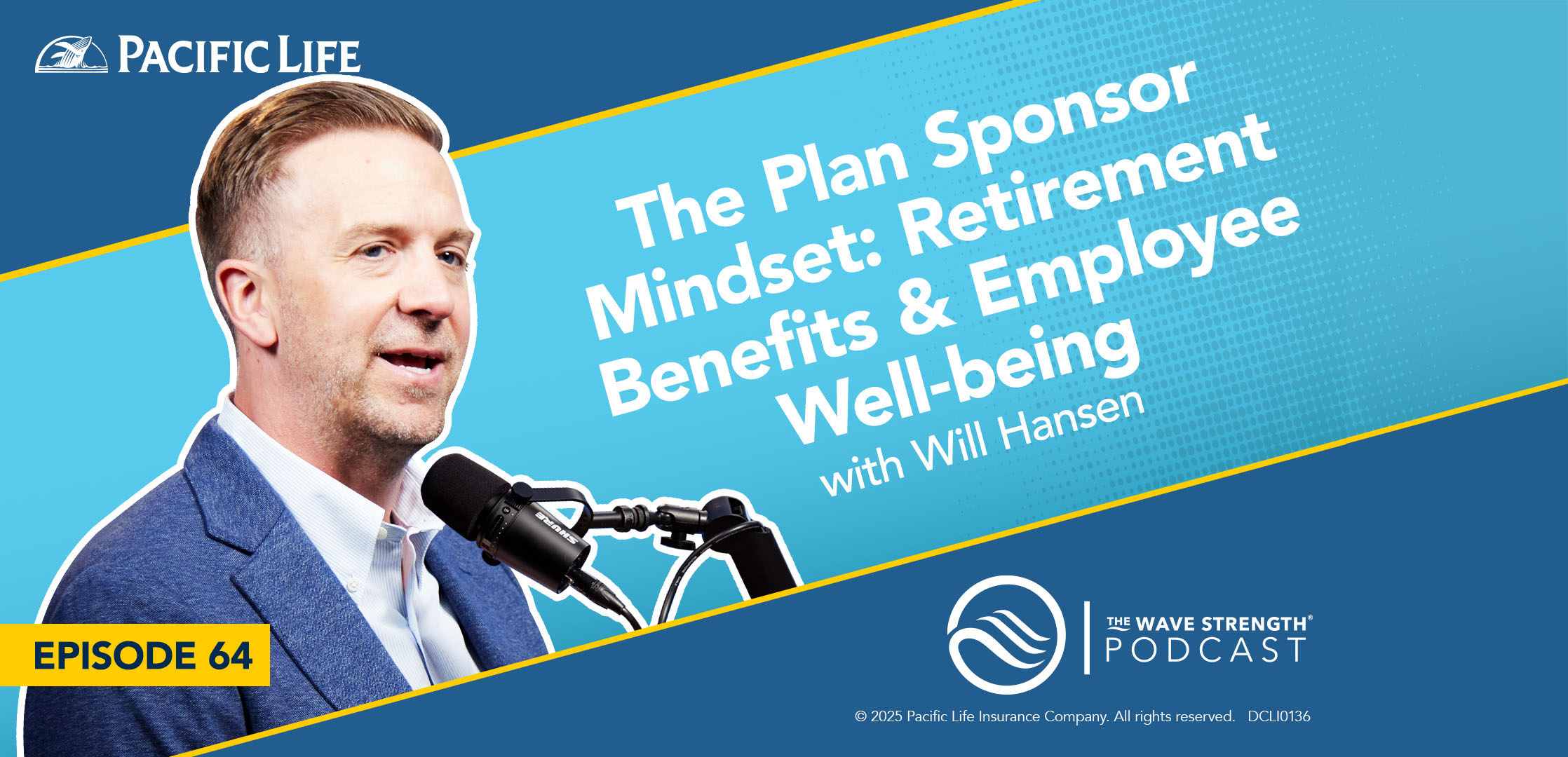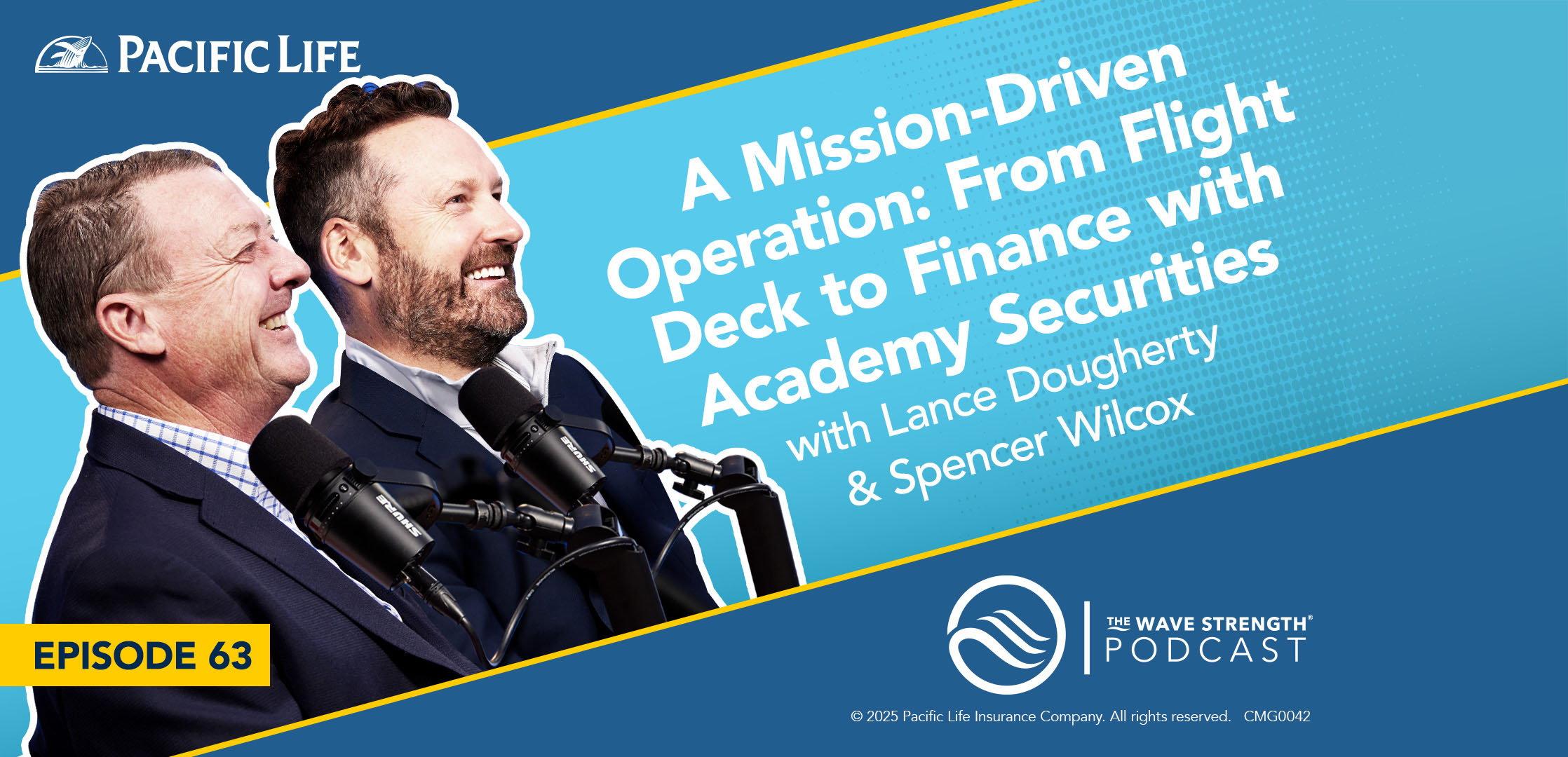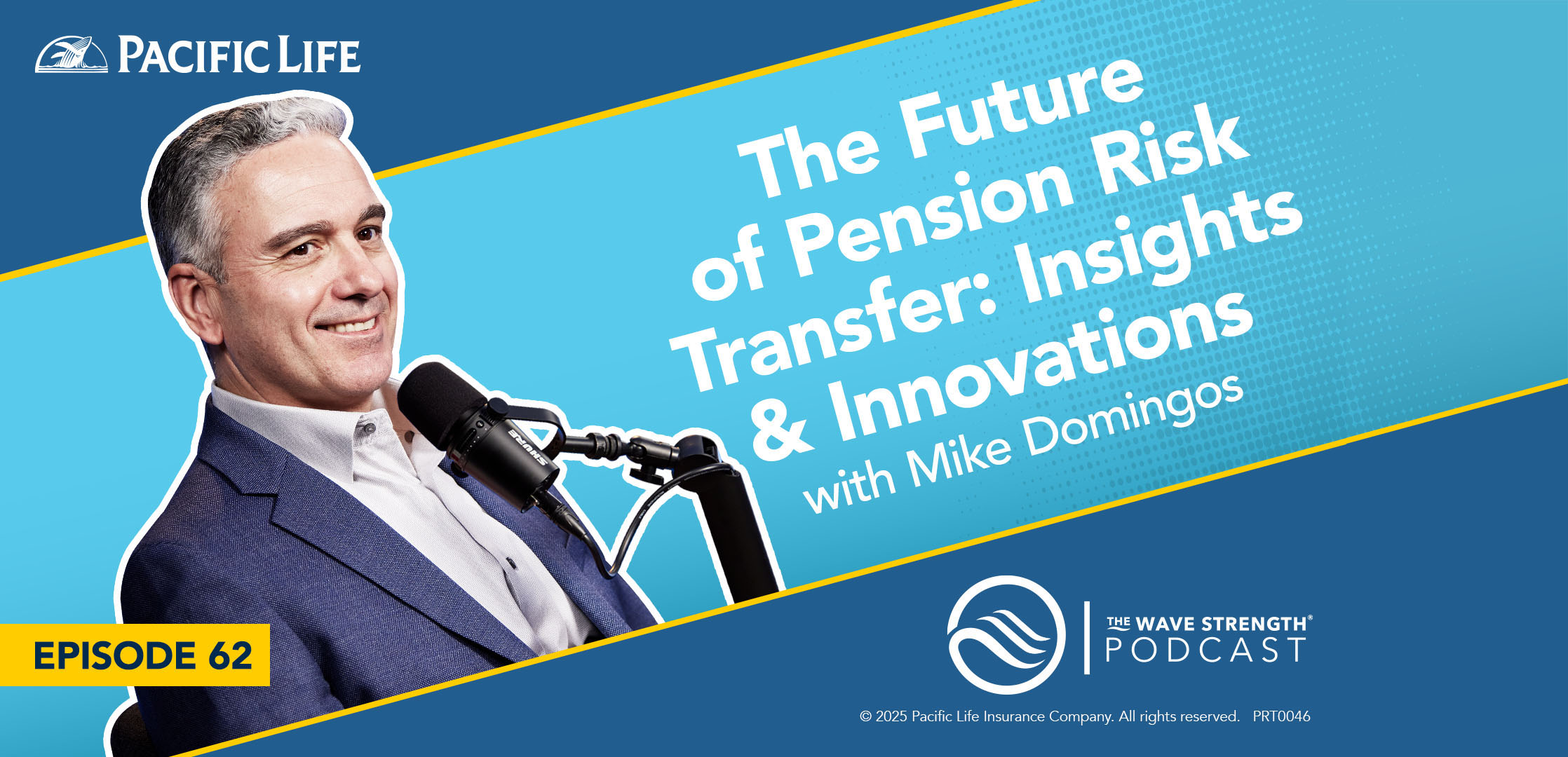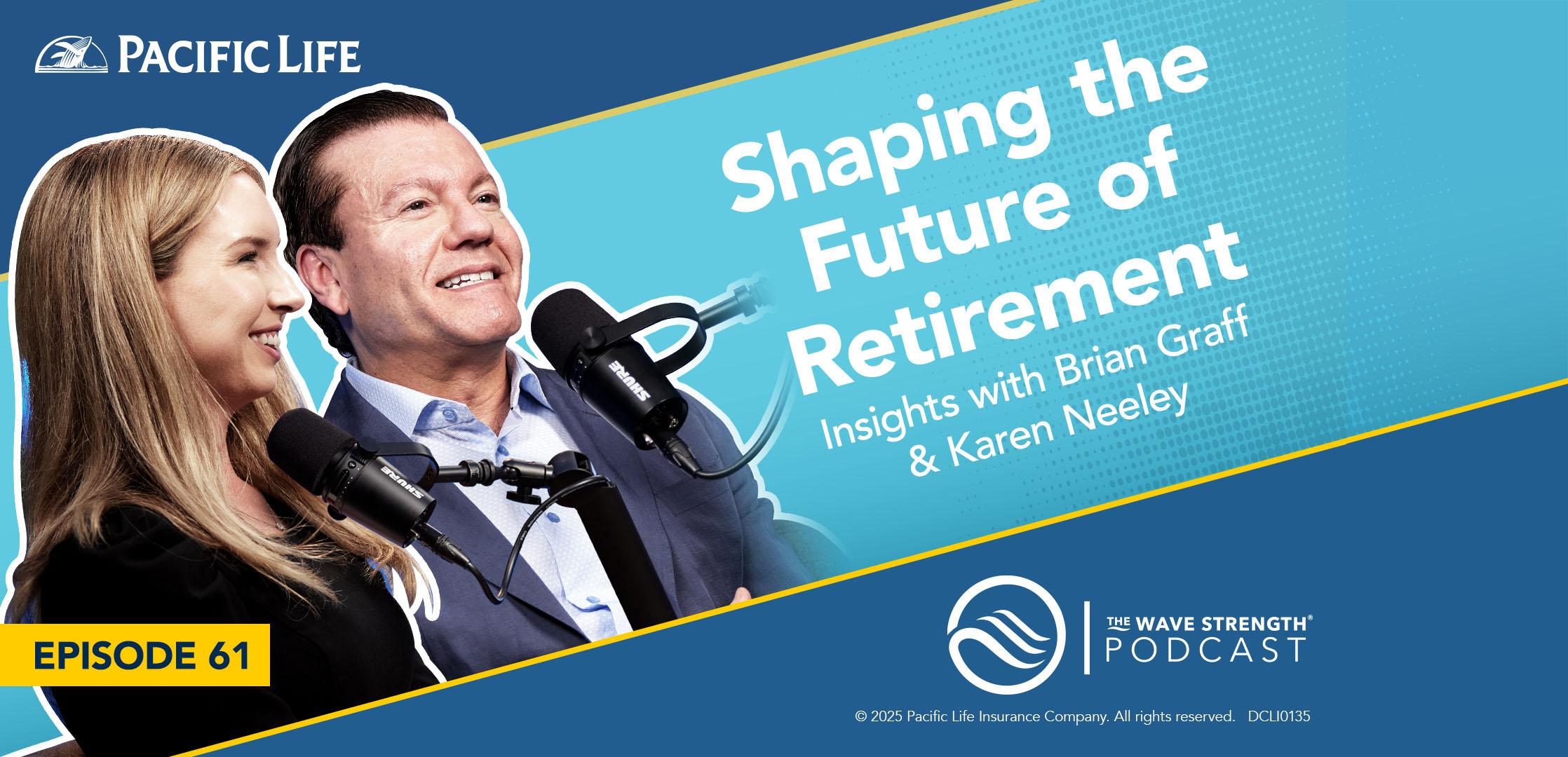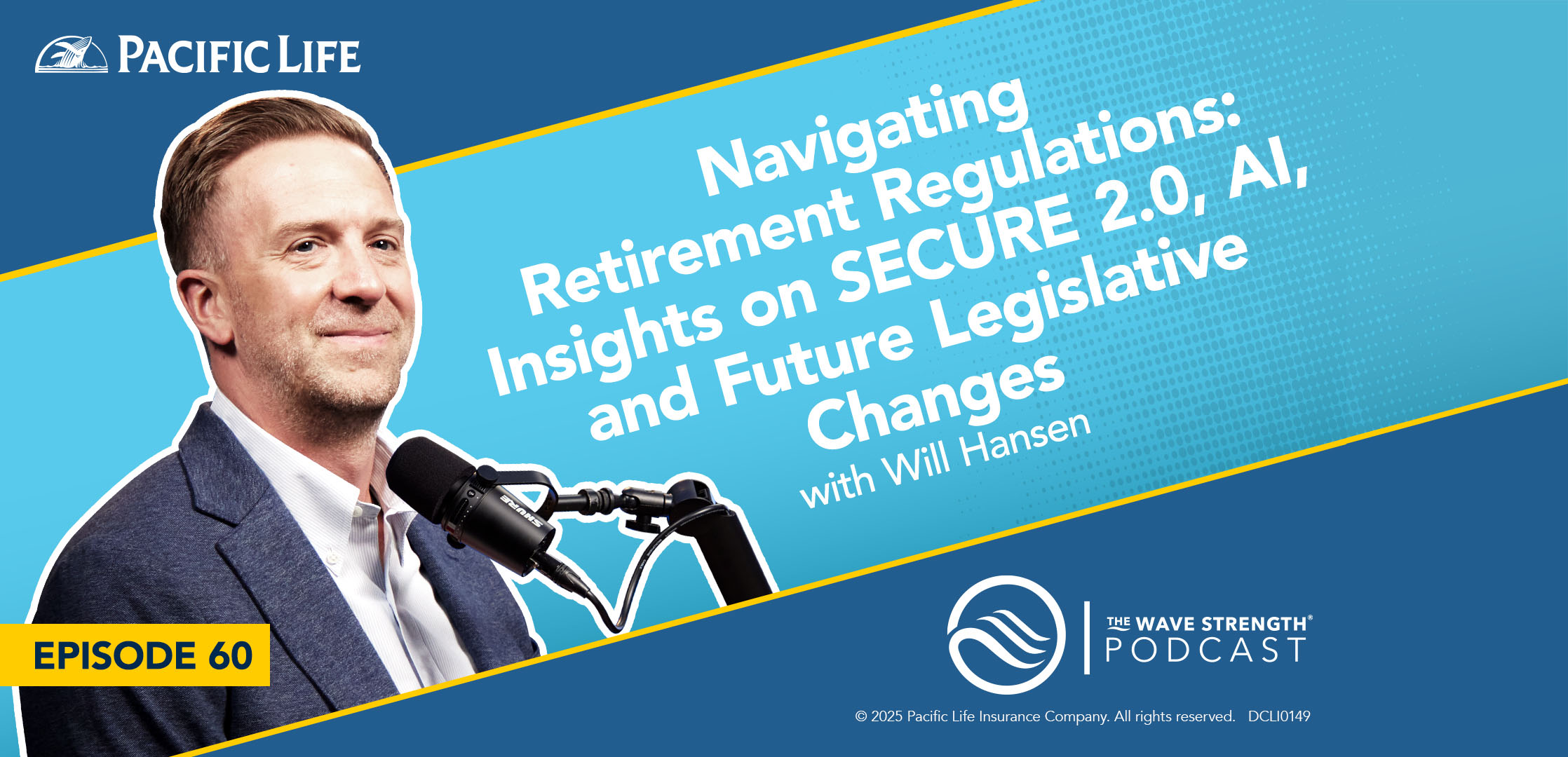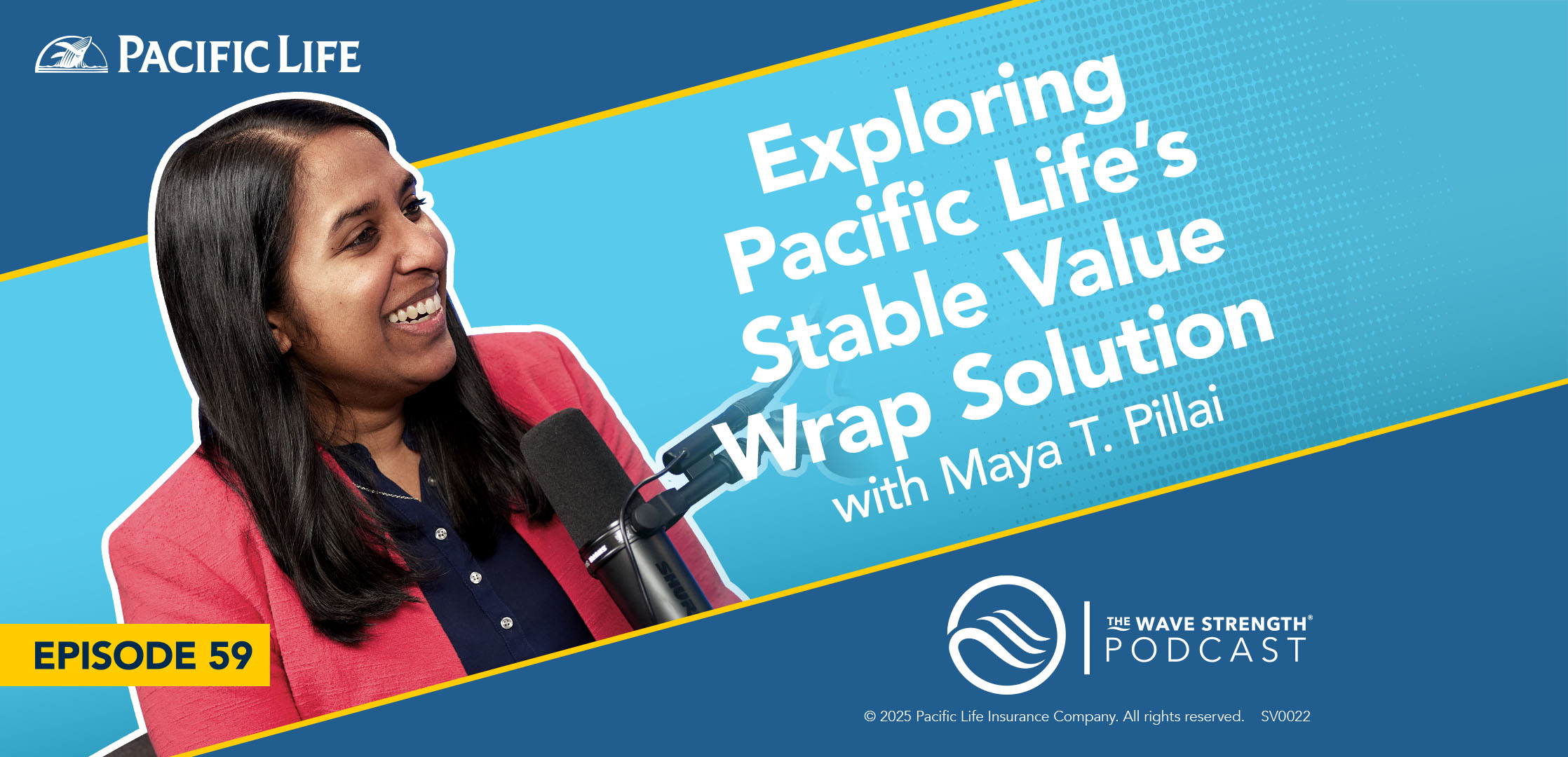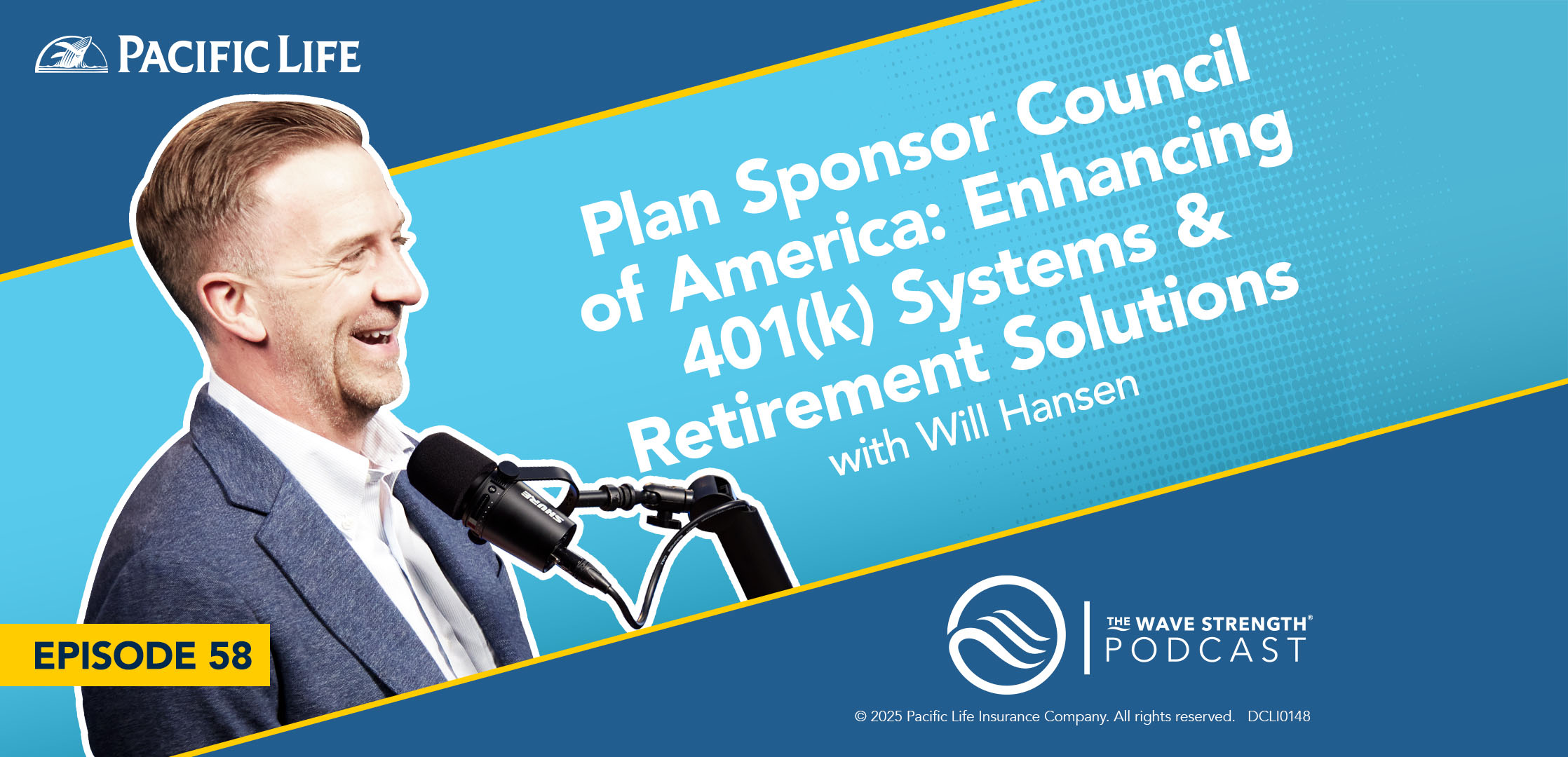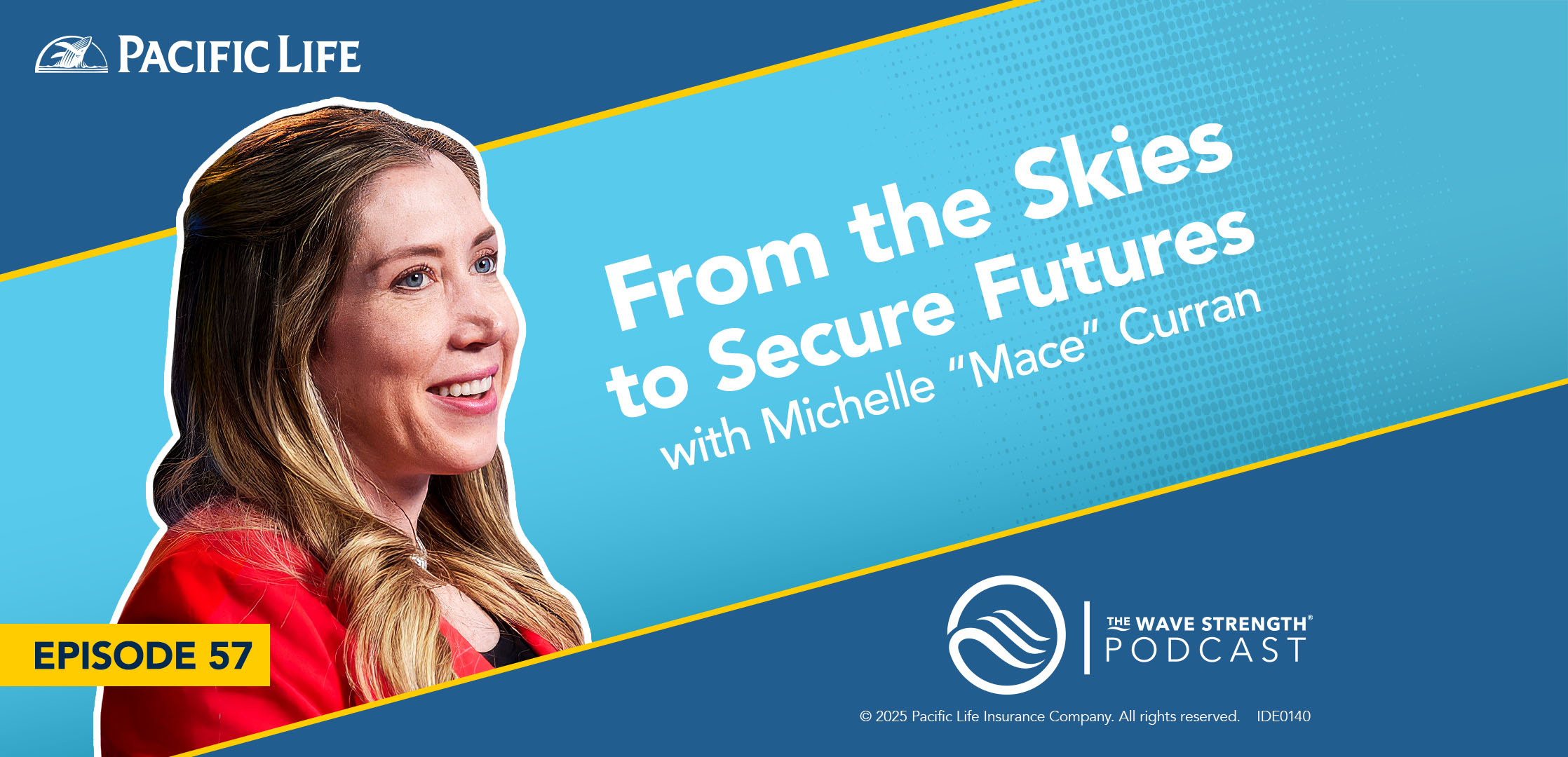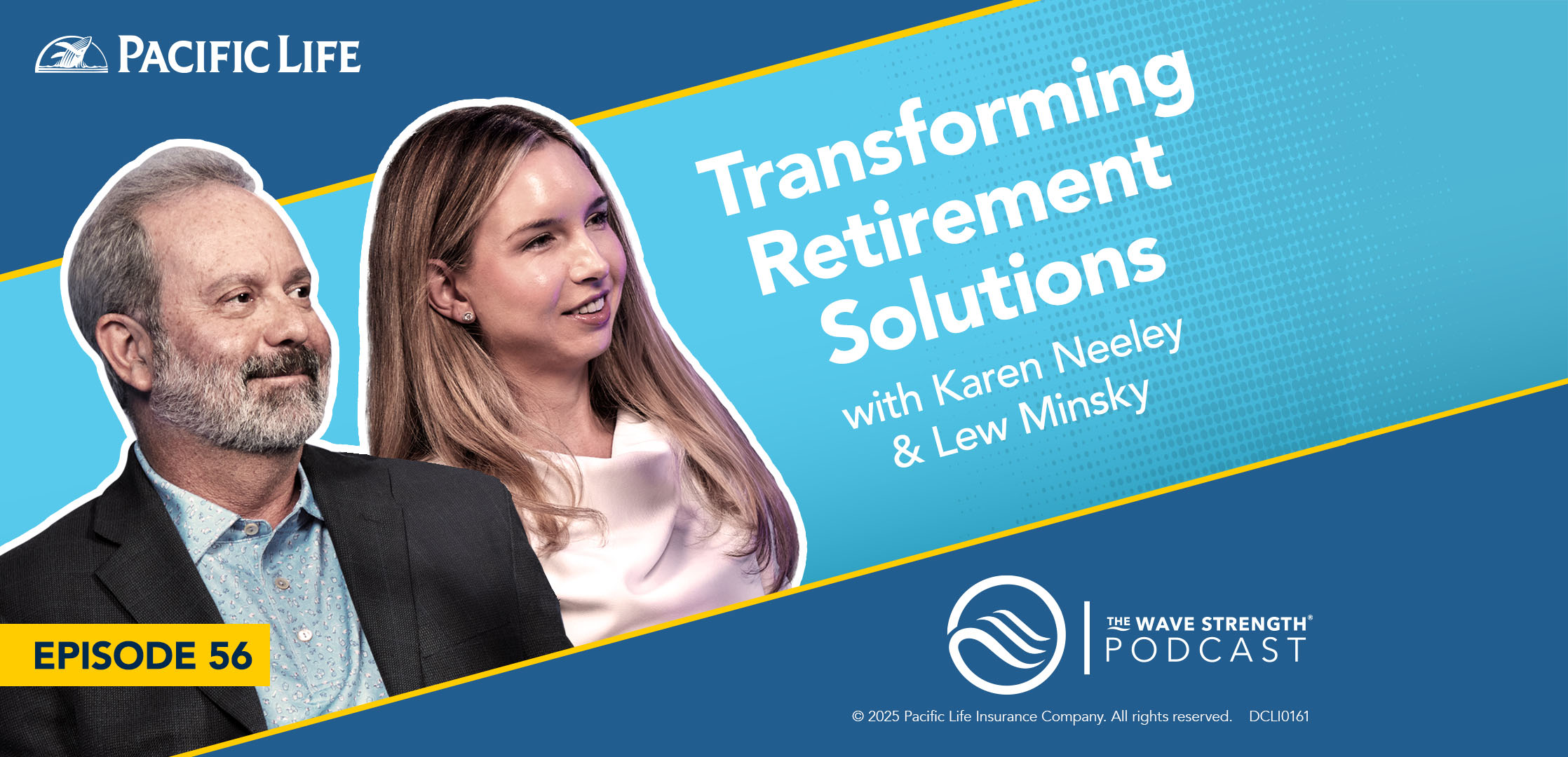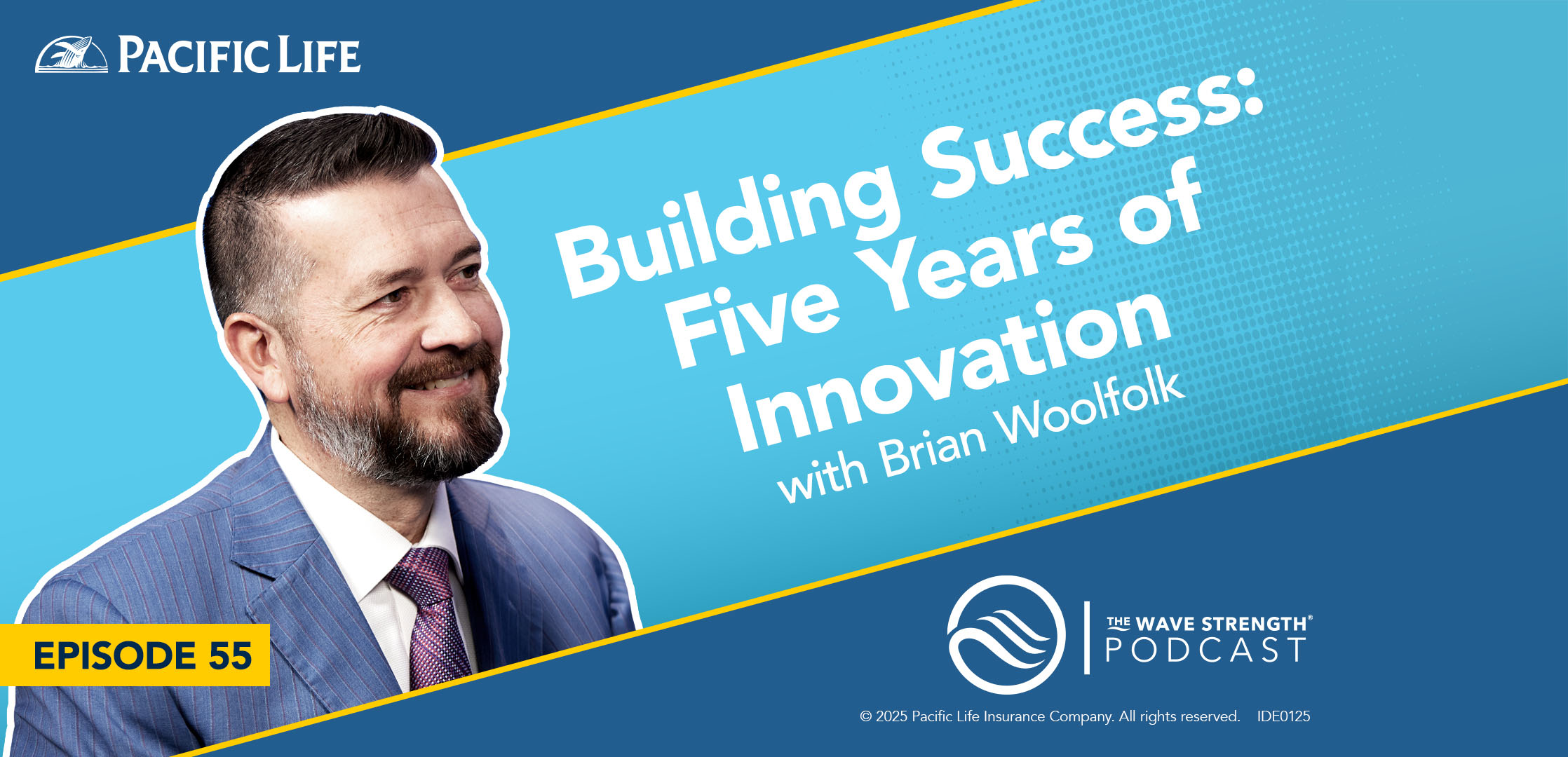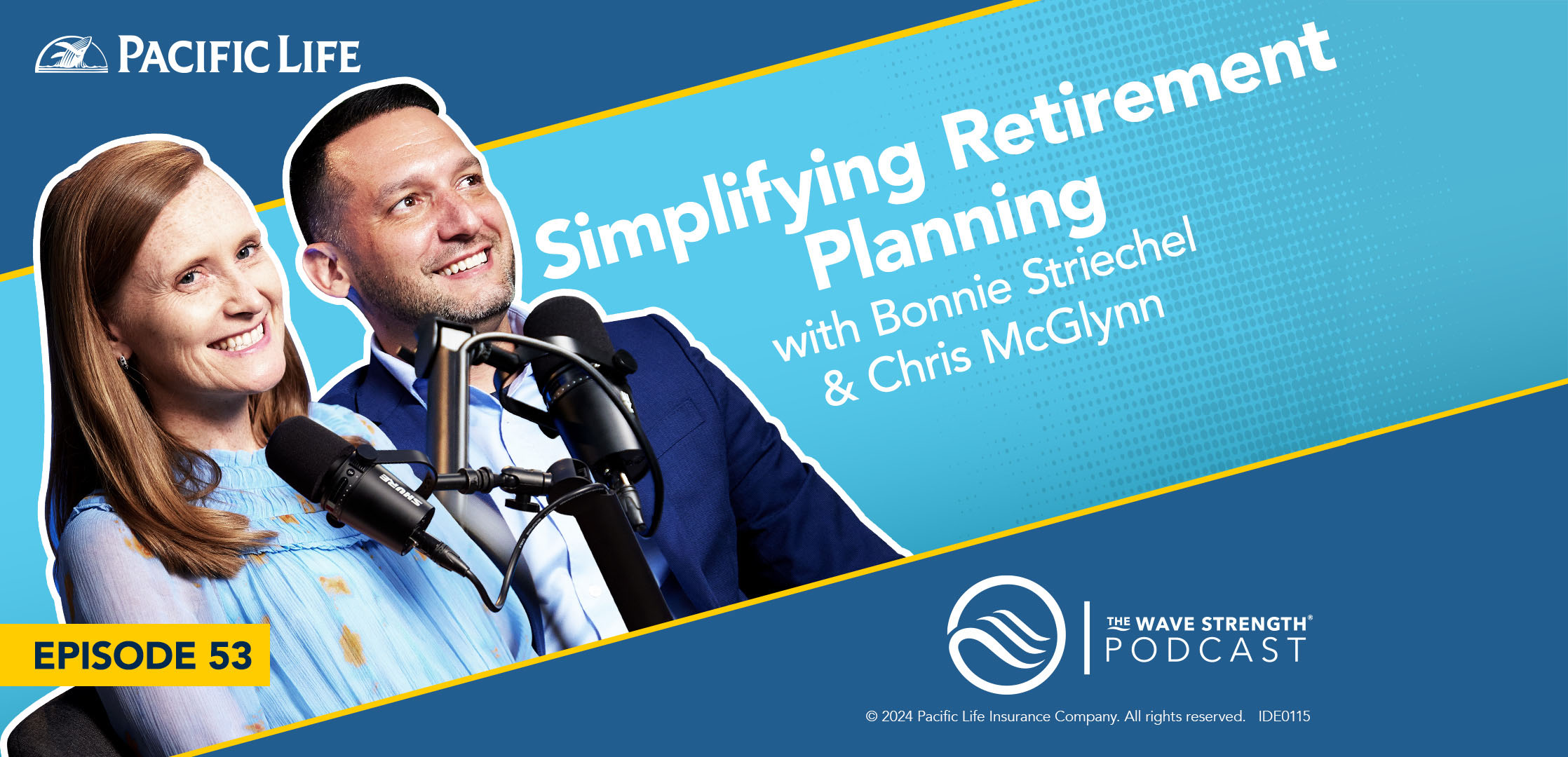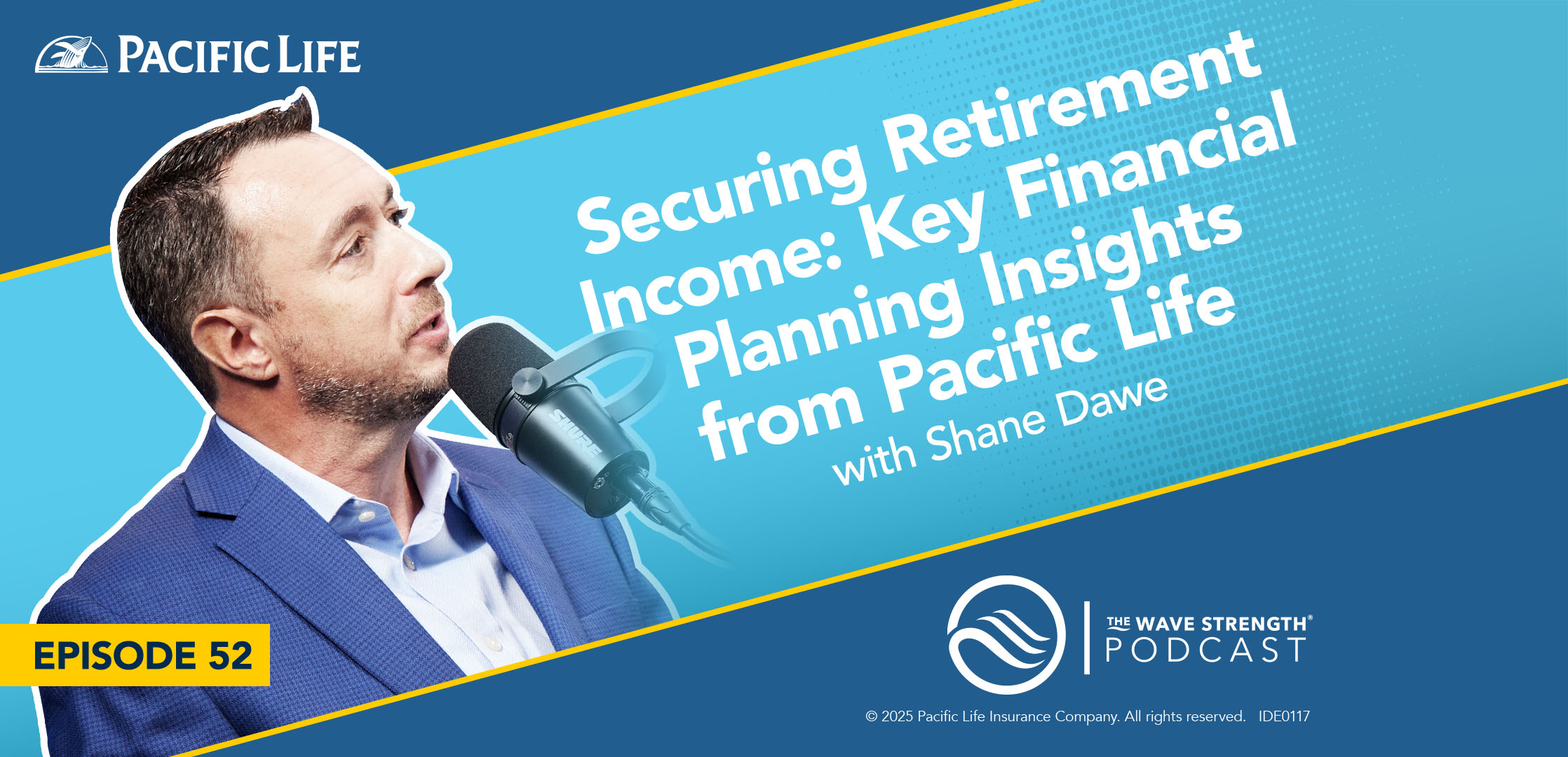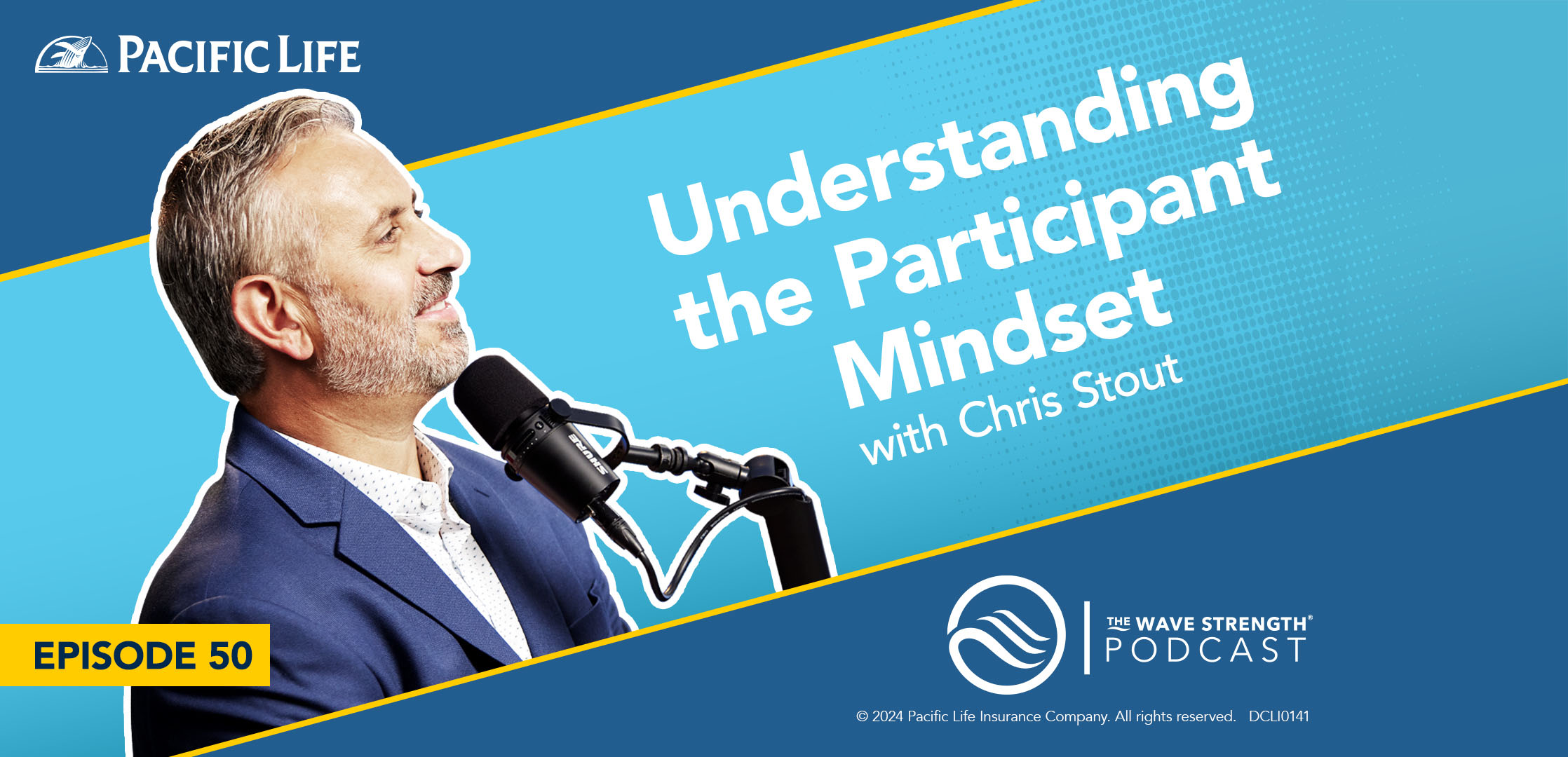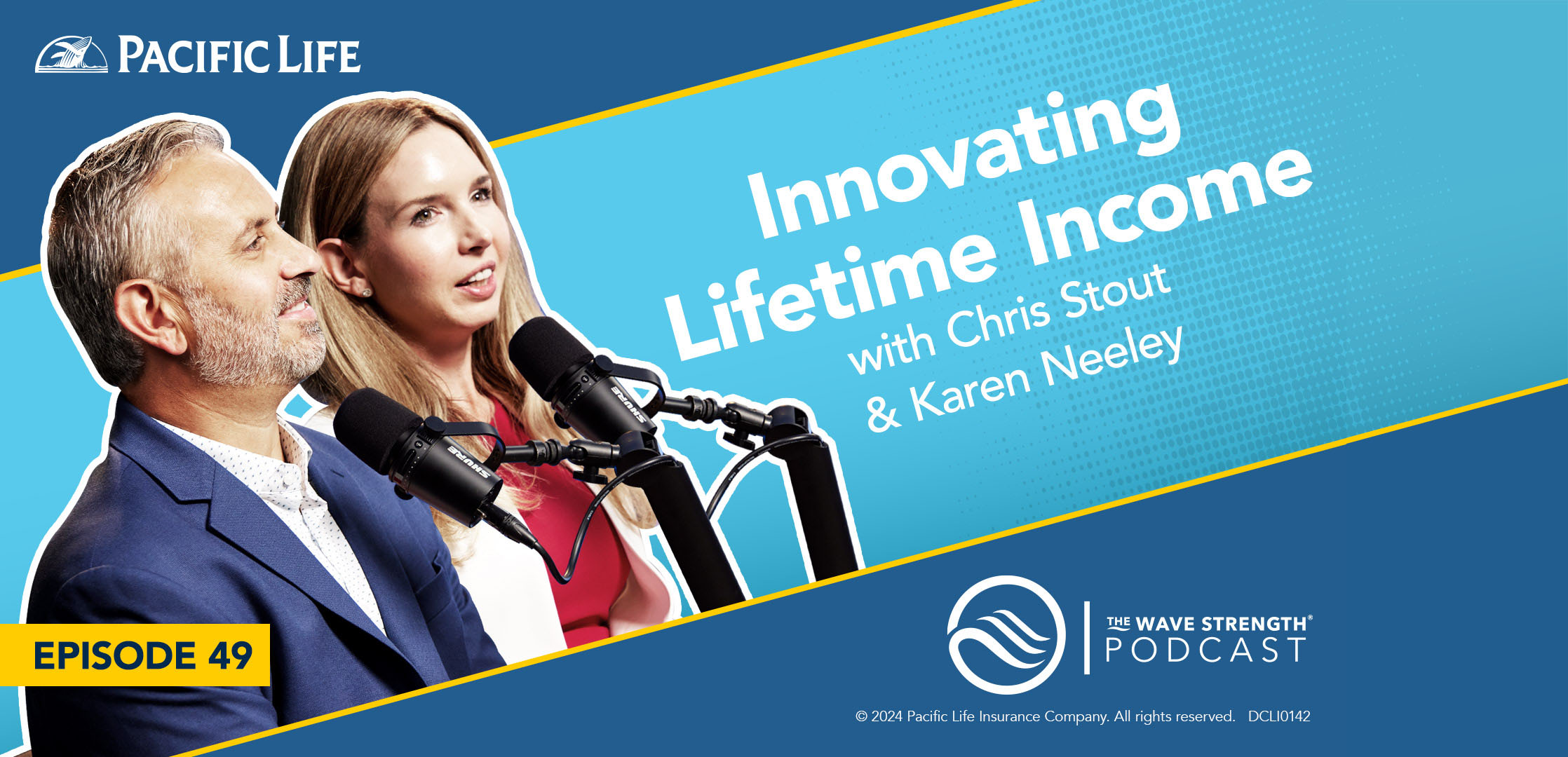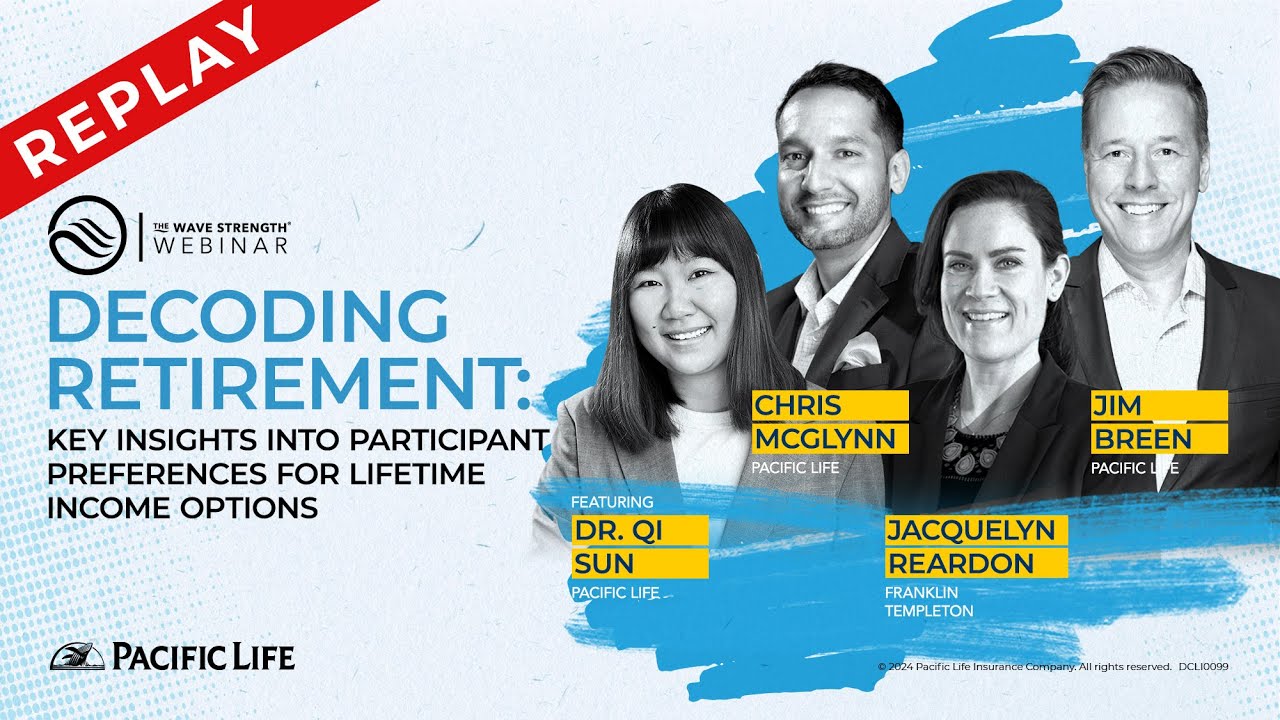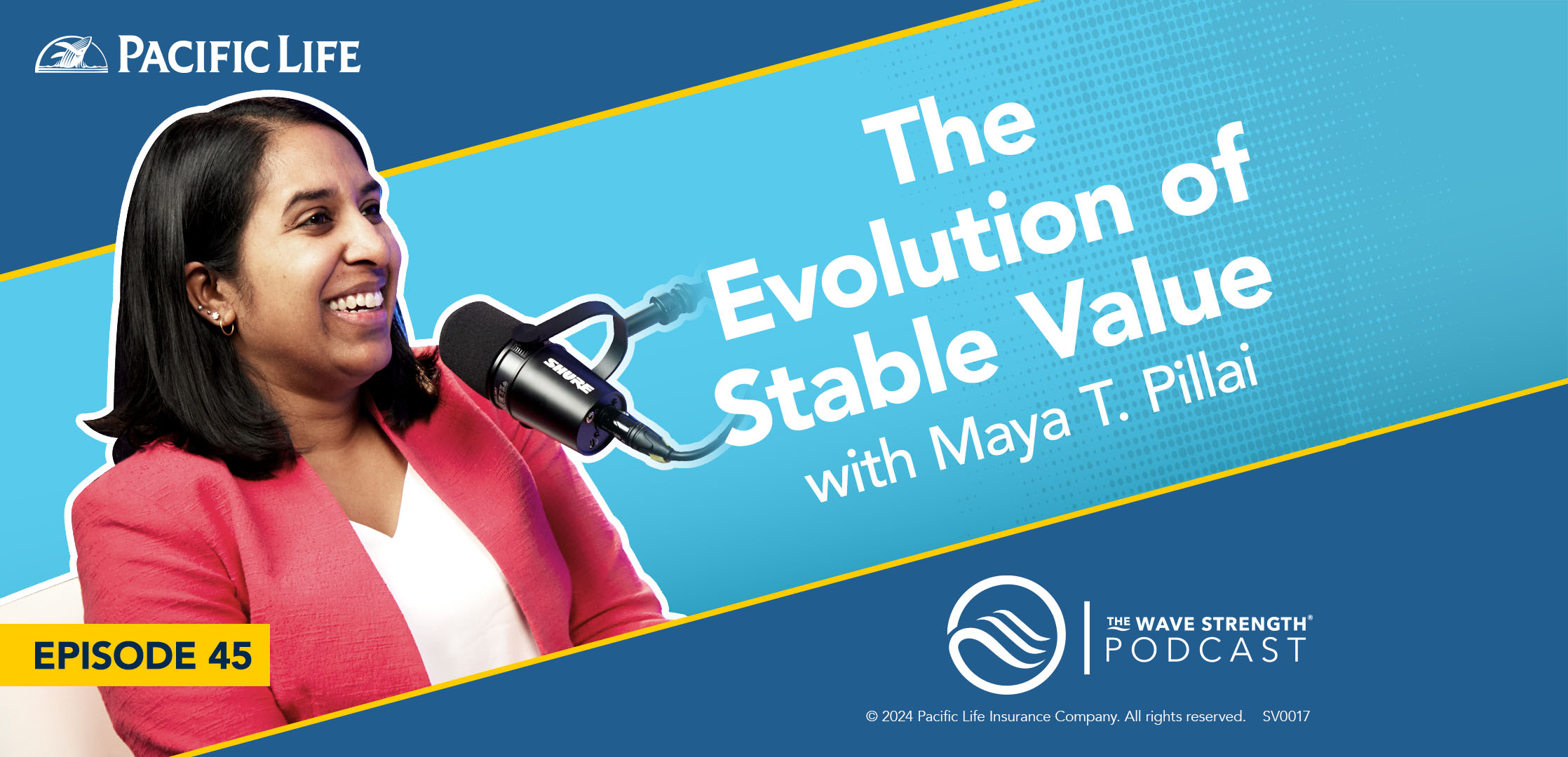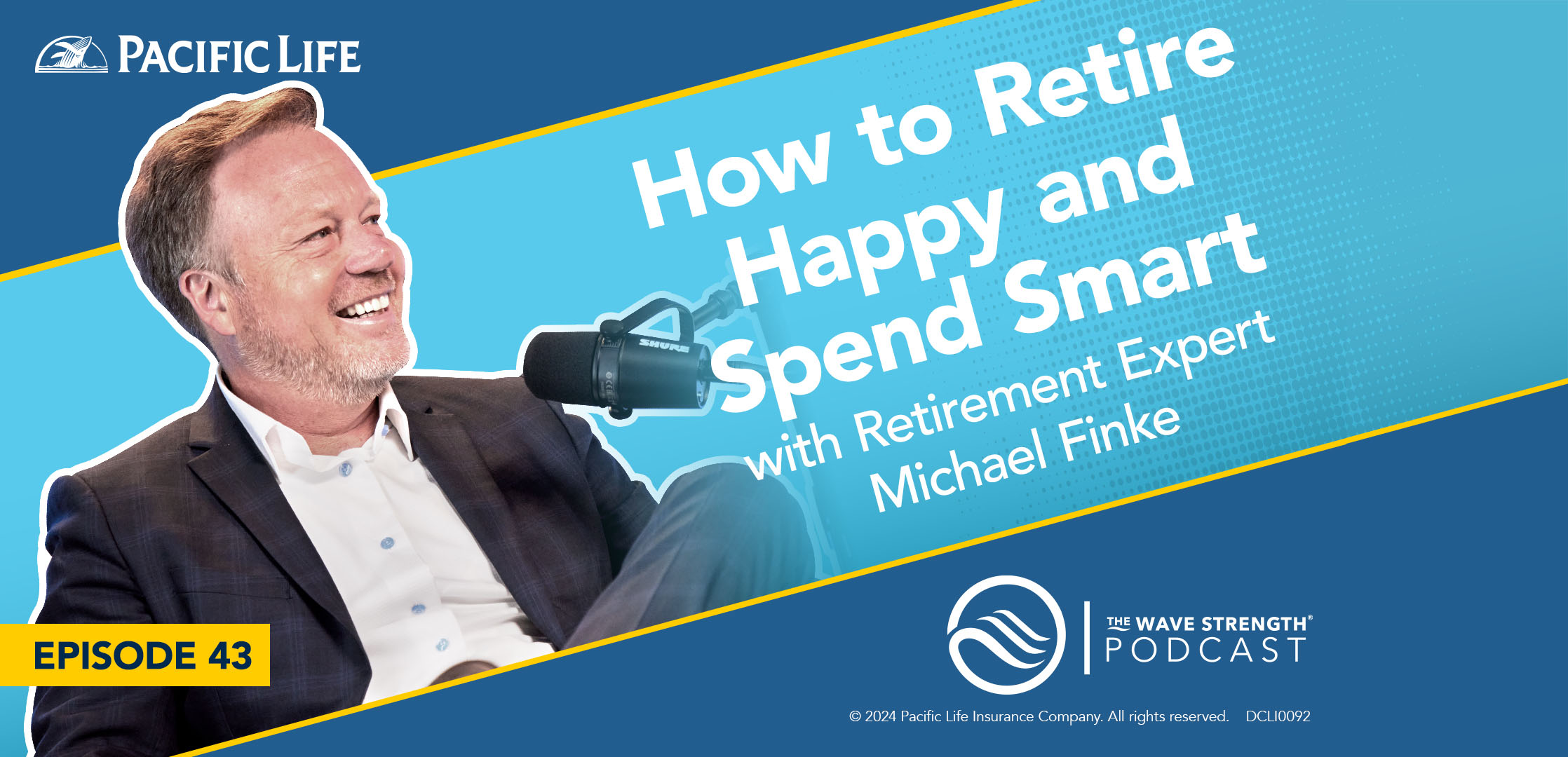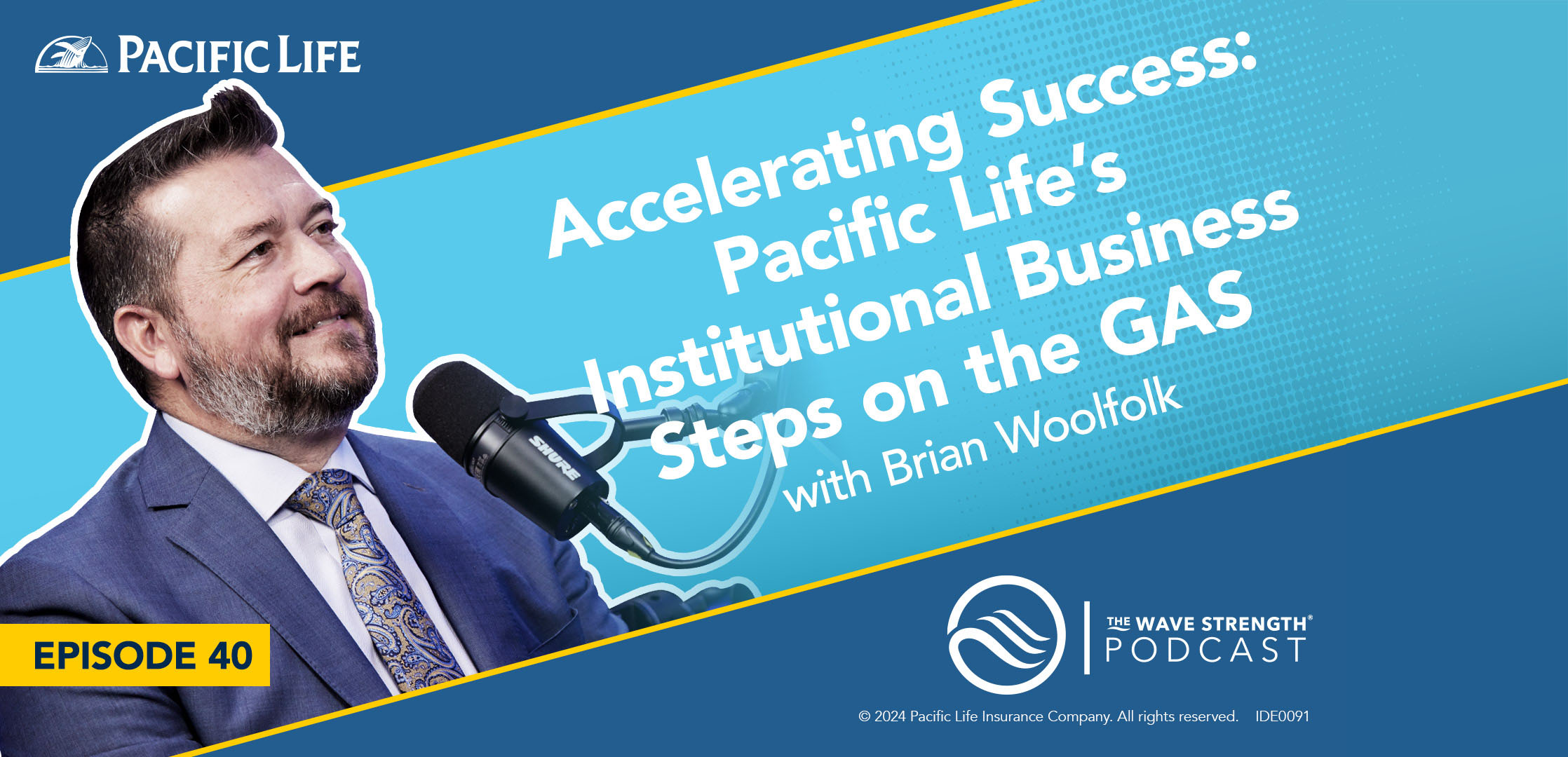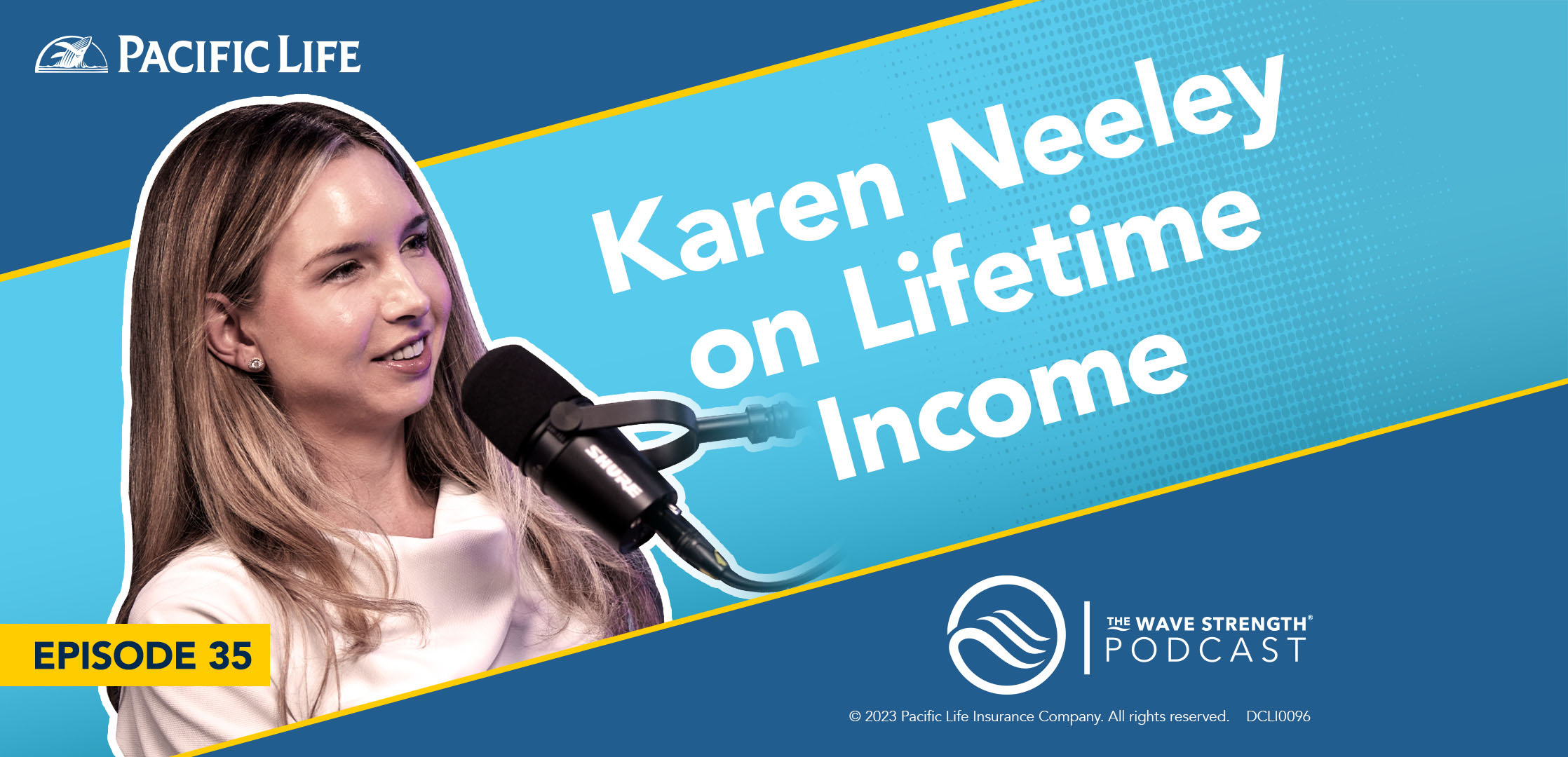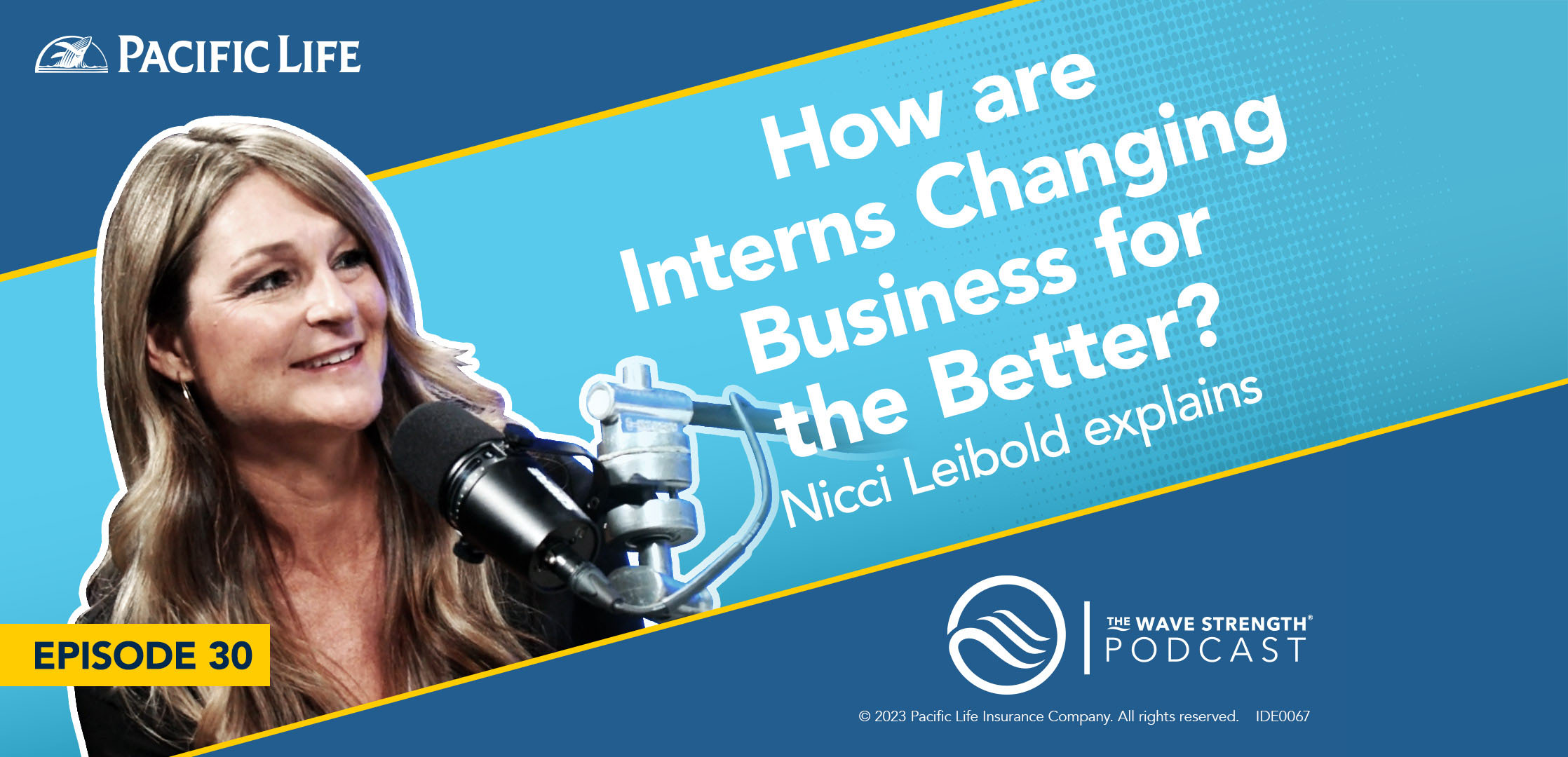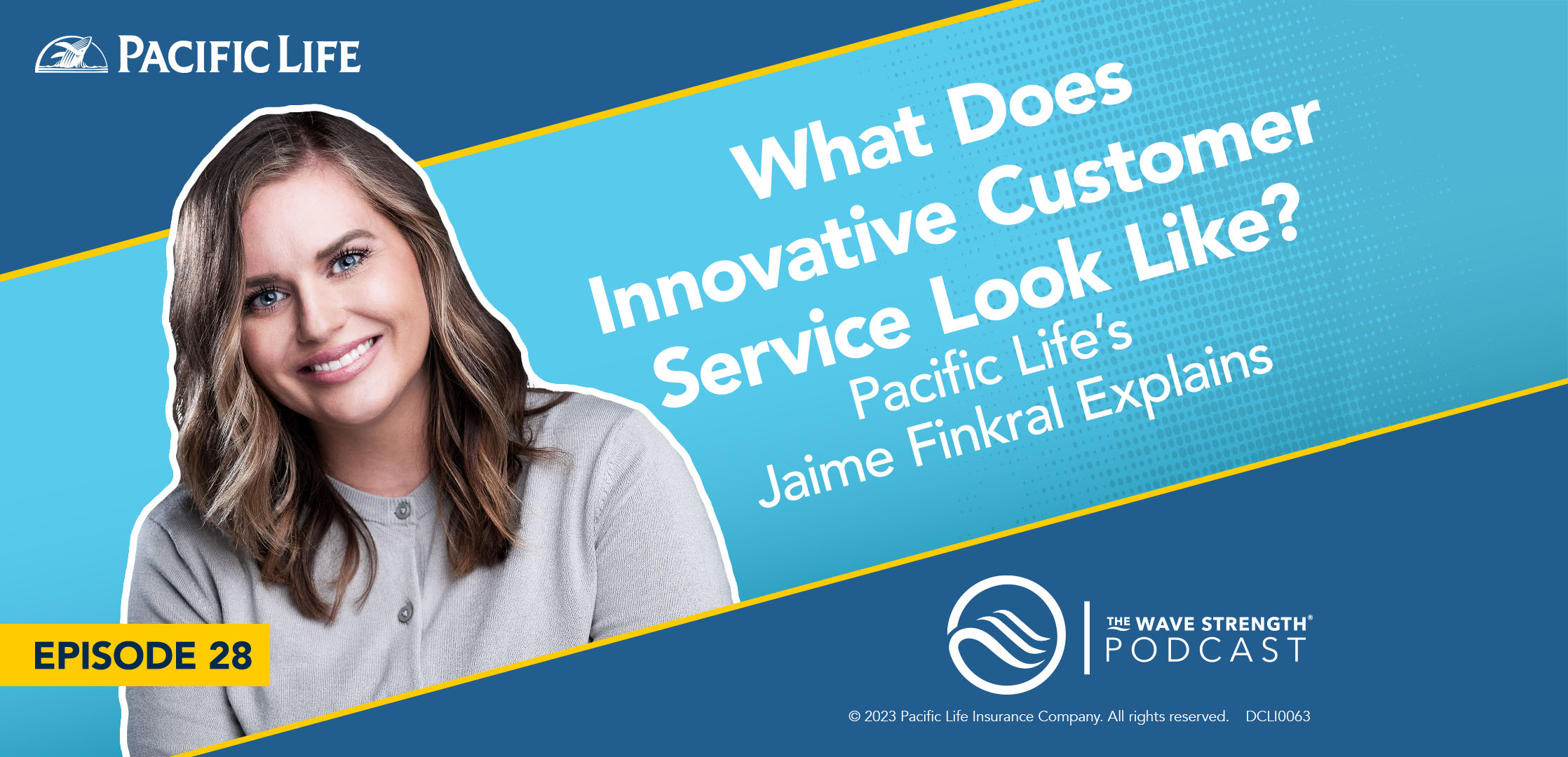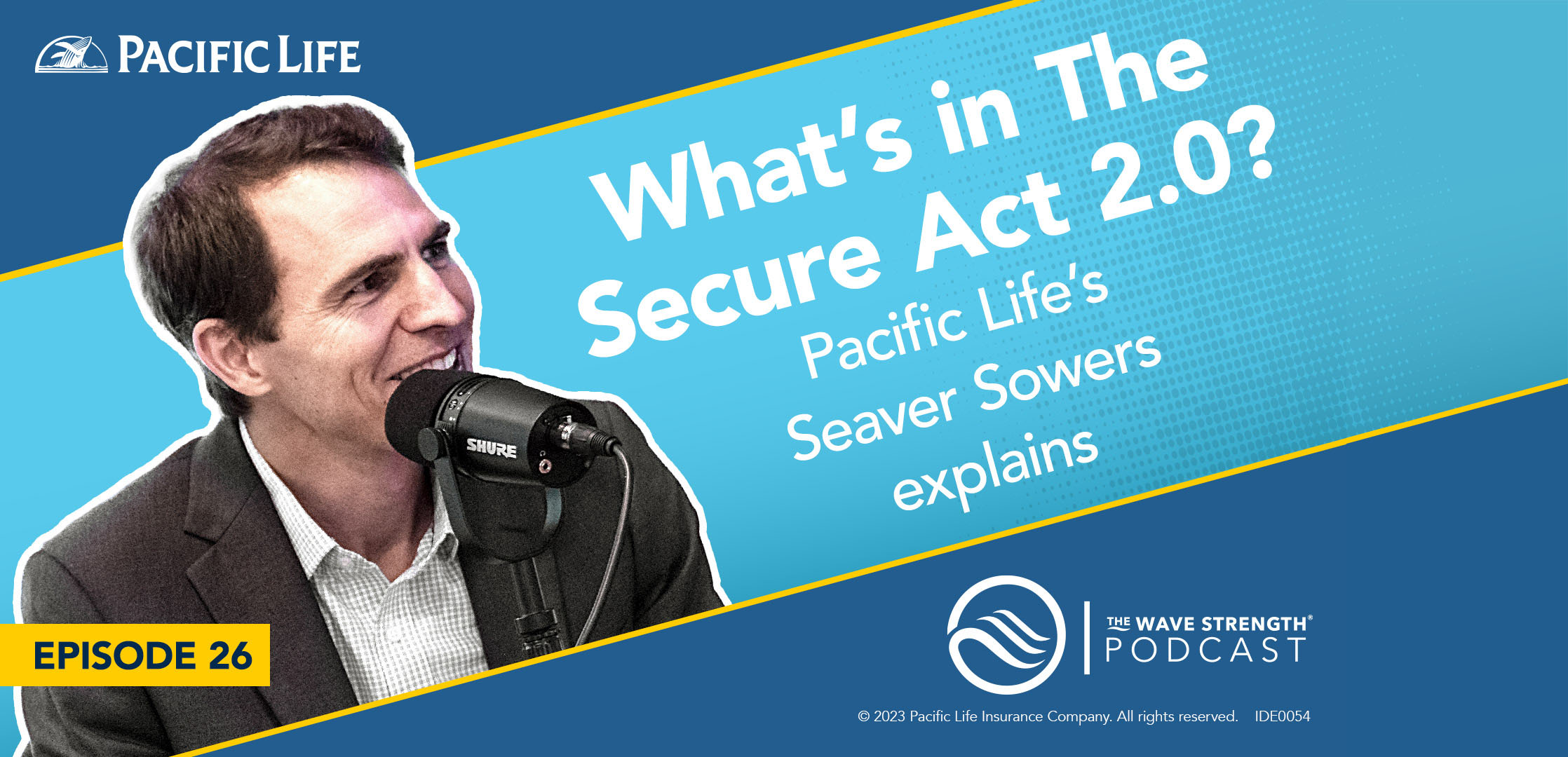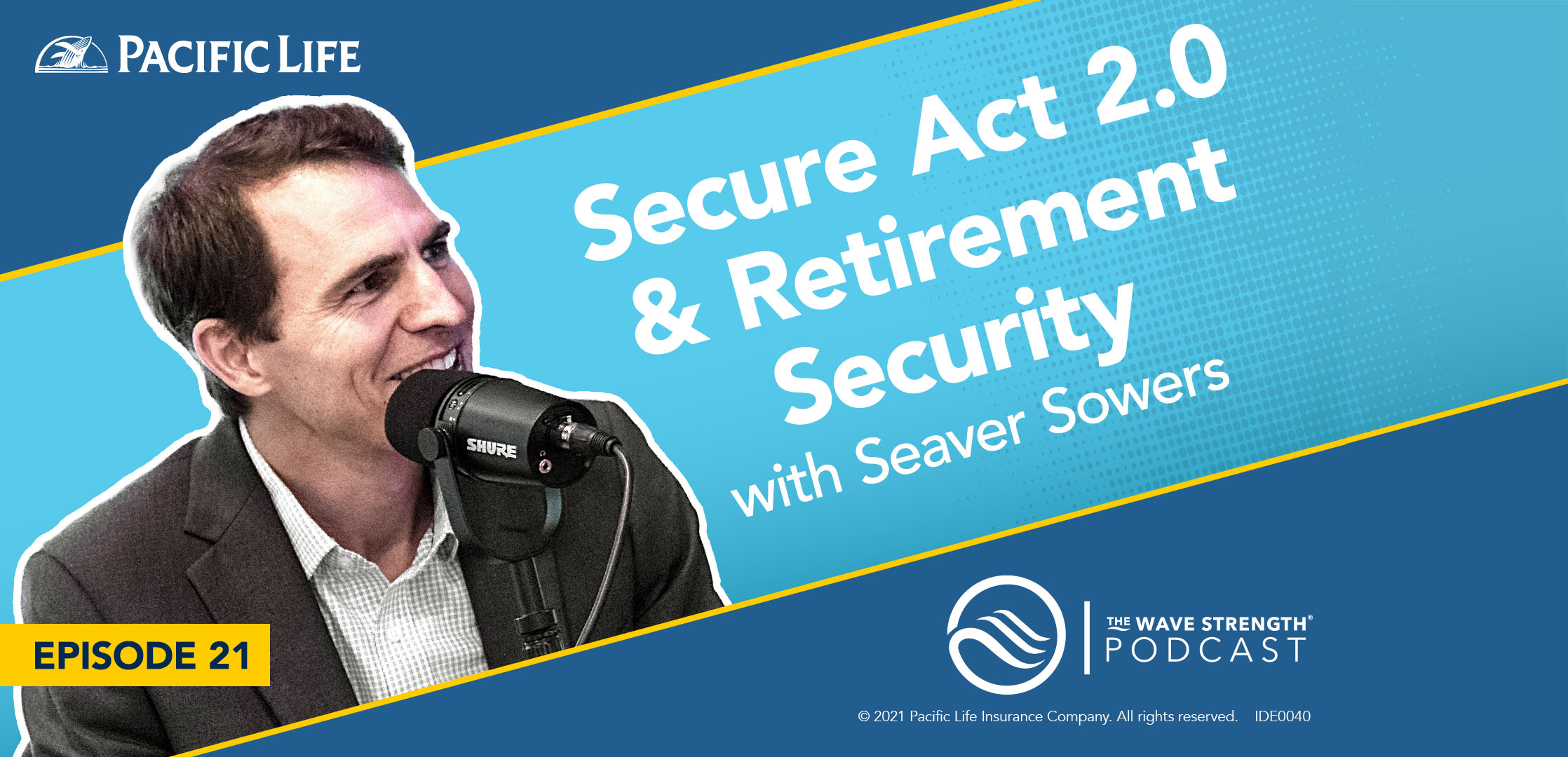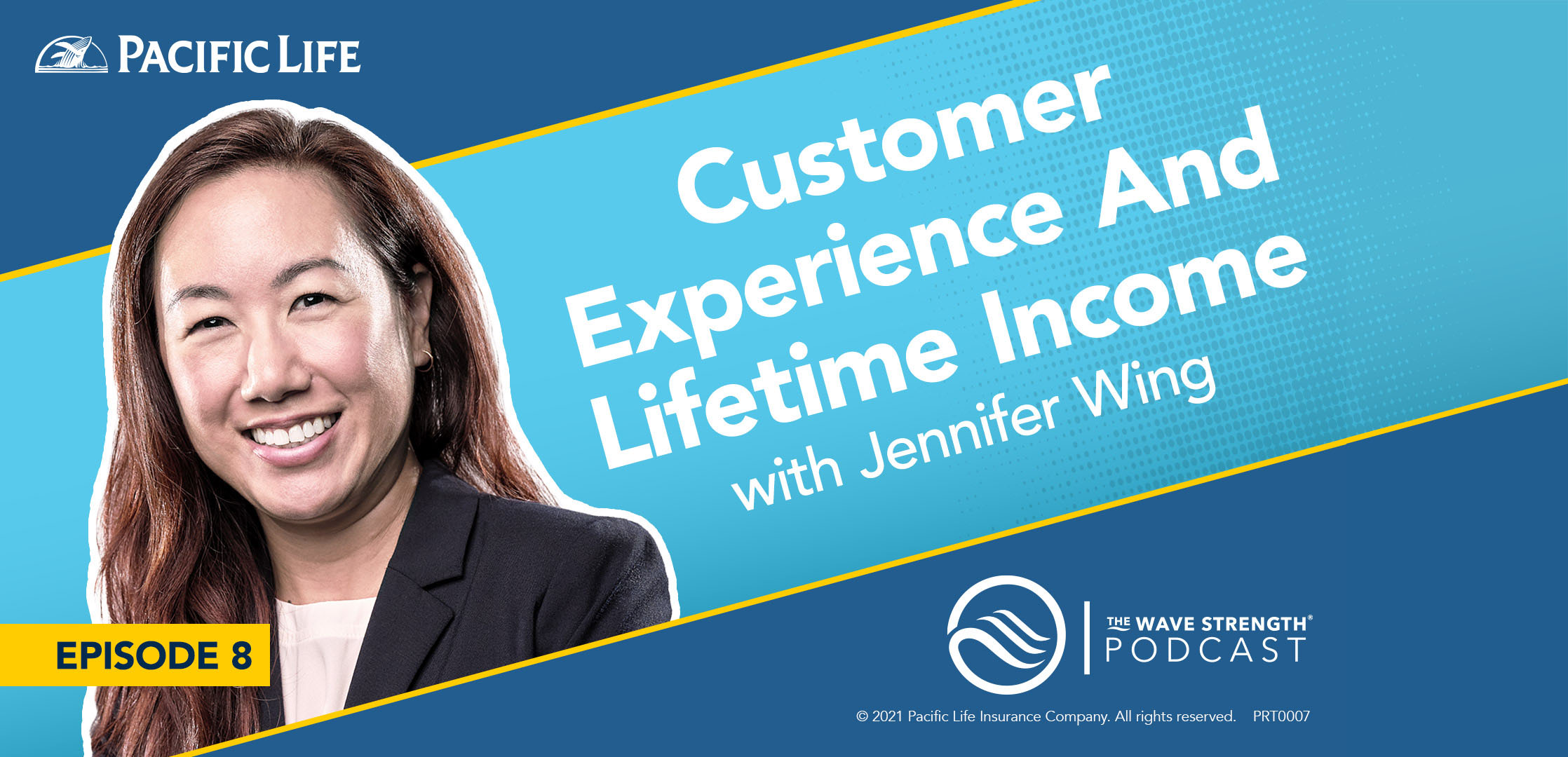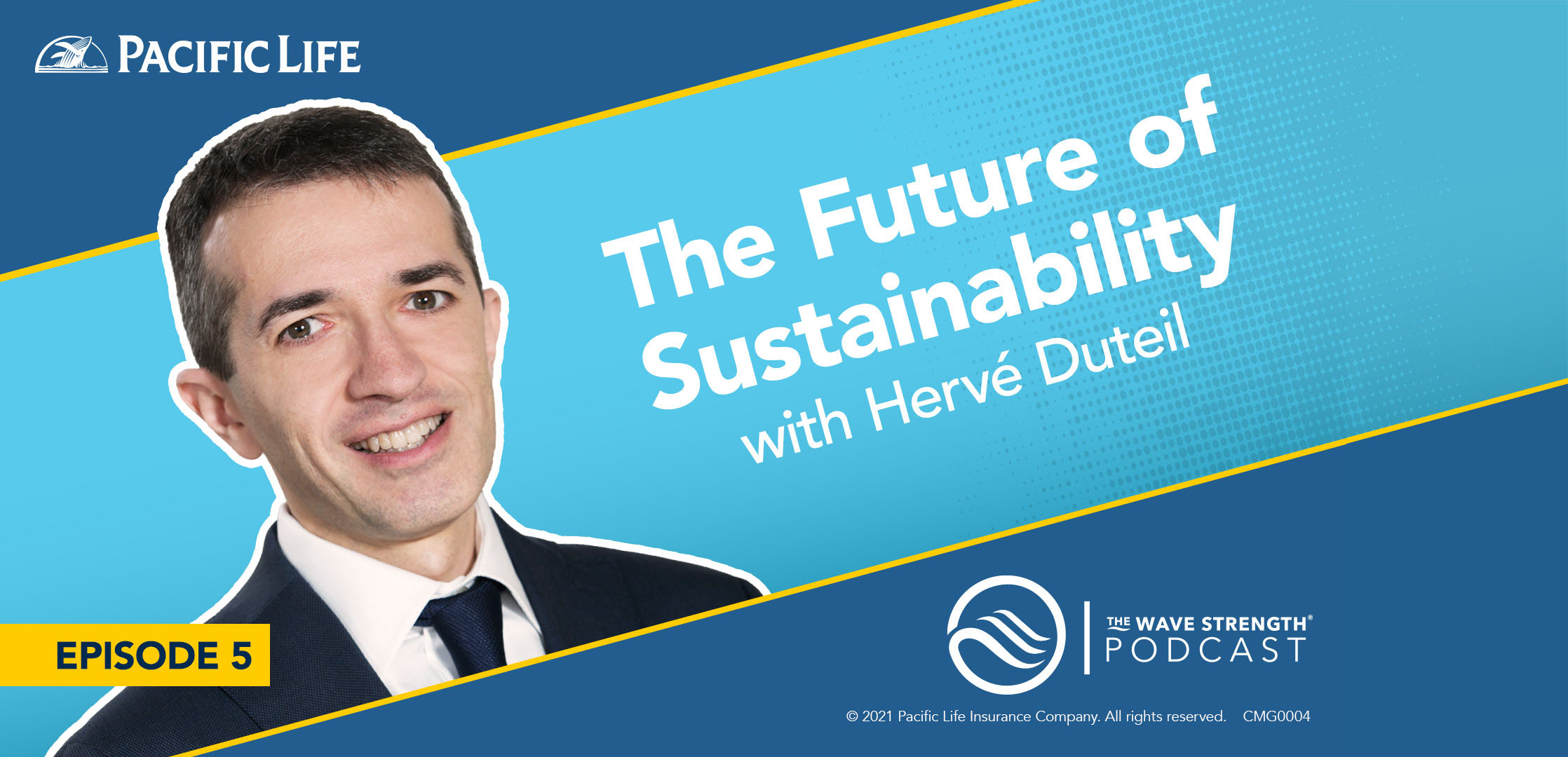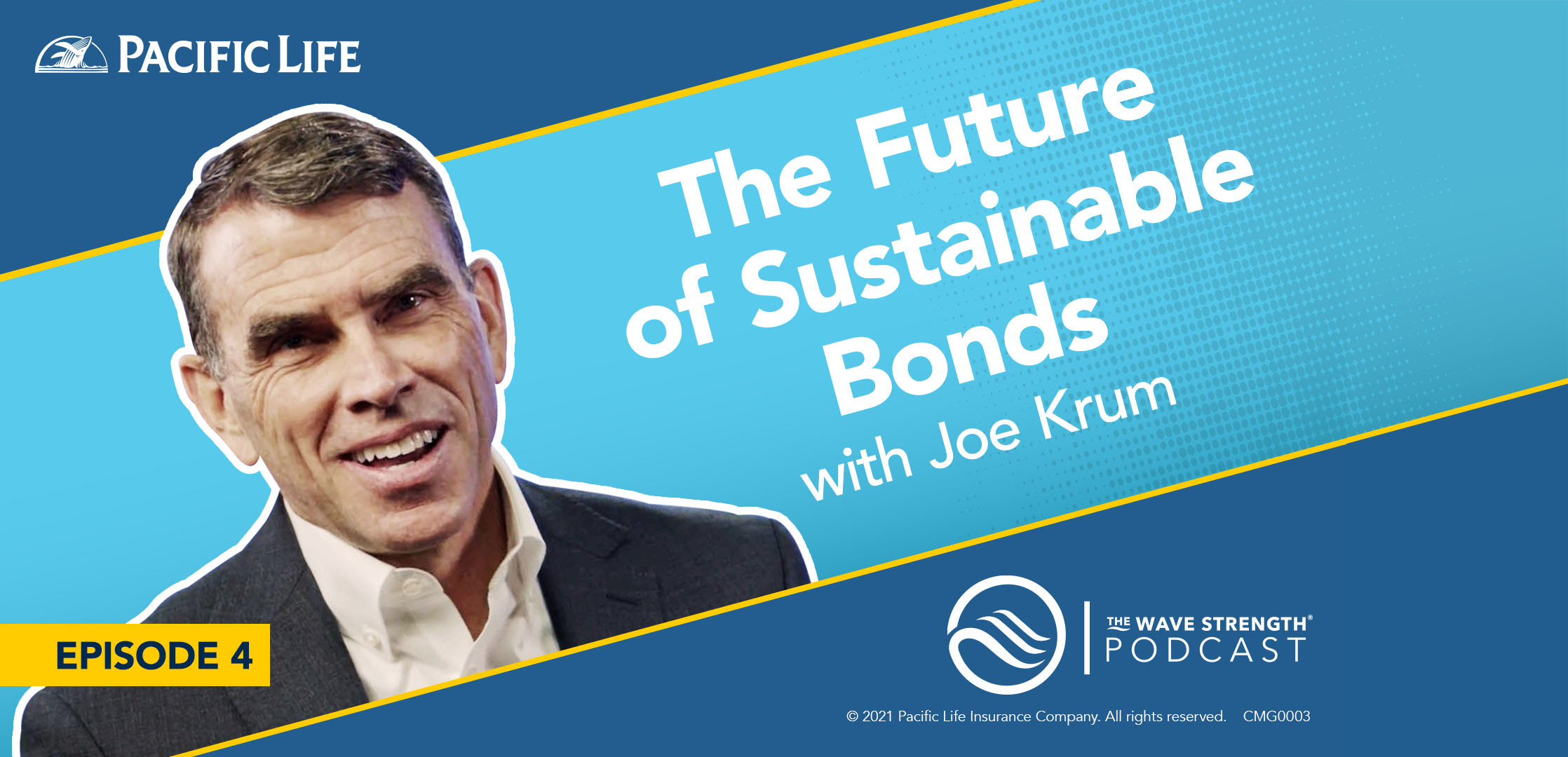Jim Breen: Learning more about the American Retirement Association.
Brian Graff: We felt having all of the segments together under one umbrella was very important.
Jim Breen: Brian Graff's work on the Hill.
Brian Graff: What we want is to make sure that the theory becomes reality.
Jim Breen: Government updates with Brian Graff.
Brian Graff: The truth of the matter is The Social Security system and the DC system work hand in hand.
Jim Breen: All this and more on today's episode of The Wave Strength.
Voiceover: Welcome to The Wave Strength Innovative solutions for a secure retirement presented by Pacific Life.
Jim Breen: Hello everyone and welcome to another episode of The Wave Strength podcast series I'm your host, Jim Breen, head of marketing with Pacific Life's Institutional team. We're very excited to be in the studio here with two important guests, both Karen Neeley with Pacific Life and Brian Graff, the CEO of the American Retirement Association.
Jim Breen: Brian, Karen, thank you both so much for being with us here today.
Brian Graff: Happy to be here.
Karen Neeley: Thank you for having us.
Jim Breen: Absolutely. What I'd love to be able to do is. Talk a little bit about the roles that both of you serve both at Pacific Life and ARA. Karen your title the head of the Institutional Retirement Solutions Group here at Pacific Life.
Jim Breen: Perhaps you could share a little bit about your background, and then Brian, I'd love to hear more about your background.
Karen Neeley: Sure, absolutely. So I am the head of institutional retirement solutions here at Pacific Life, and that includes our pensioners transfer and our defined contribution lifetime income business.
Karen Neeley: So I've been here for a little over a year, grew up in the record keeping space, was in the record keeping side for about two decades, really working on a variety of roles from pricing to strategy. To really driving our footprint in the market. So excited to be here and, overseeing that retirement of today, our pensioners transfer business and the retirement of tomorrow, our defined contribution lifetime income business.
Jim Breen: Fantastic. And you've been on the podcast many times. So thanks so much for coming back. I really appreciate that. Brian, thank you again for joining us. Excited to learn more about you and the great work that A. R. A. has currently underway. Perhaps before we jump into that great work, maybe you can share with our audience a little bit about your background, Brian.
Brian Graff: Sure. So I've been at the American Retirement Association now going on 29 years.
Jim Breen: Just a couple of years.
Brian Graff: Just a few years. Yeah, I finally vested. And I worked on Capitol Hill prior to that as essentially Congress's pension ERISA lawyer. As you probably could imagine, there's not a lot of inherent ERISA expertise in Congress.
Brian Graff: So they rely on staff to, to help them sort things out and drafted the Retirement Protection Act and the Small Business Job Protection Act, which were some pretty cool things that changed the retirement plan landscape, including the 401k safe harbor. We invented the simple plan in that legislation.
Brian Graff: That's what kind of led me to the American Retirement Association. So I've been involved in the benefits world for quite some time.
Jim Breen: Fantastic. And there is so much that ARA is currently doing. Those that are familiar with the show are familiar with the episode that we recently launched. With Will Hansen from ARA handling a lot of the PSCA side of the house.
Jim Breen: And I'd love to talk more about that, but perhaps right now you can dive a little deeper into the, sister organizations that fall within ARA. Cause there, there are a few.
Brian Graff: Yeah, absolutely. There's five and. Go through the list. This is the American Society of Pension Professionals and Actuaries, ASPA, which is essentially the folks who do administration and record keeping for the retirement plan industry, both defined contribution and defined benefit.
Brian Graff: NAPA, which is the National Association of plan Advisors. So the fiduciary advisors that work with plan sponsors to ensure that their investments are, evaluated and work with plan sponsors also to educate. Participants about the importance of savings. There's also the National Tax Deferred Savings Association, which is more in the nonprofit governmental space for 403 B and 457 plans.
Brian Graff: And then finally there's there's two others. There's the American Society of Enrolled Actuaries because defined benefit plans need an actuary and actuaries need their own organization. And finally As you mentioned the Plan Sponsor Council of America, it, the, system is, very segmented, which can be a little bit seem complicated from outsiders, but they all also work very well and connected together.
Brian Graff: And so we felt having all of the segments together under one umbrella was very important for our mission, which is primarily, to advocate for the strength of the system to grow the retirement plan system to make sure the government doesn't mess it up too badly. And then finally to educate the folks in the industry across the board, whether it's advisors, administrators, record keepers and plan sponsors so that they can do the best job they can helping participants save for retirement.
Jim Breen: Absolutely. I know Karen and I had the pleasure of joining our teams at the 2024 NAPA 401k summit in Nashville several months ago. And, what a phenomenal experience. I know we've been a few times before, but I was sharing with Brian before we started, Karen, there's something unique about these conferences.
Jim Breen: There's an energy, or as Will Hansen and I were talking about in that podcast, a spark, if you will, that you sense. And maybe you can share your thoughts a little bit about that, Karen.
Karen Neeley: Yeah, I've had the privilege of, joining plenty of the NAPA conferences of the past. And I think each year it seems to keep building and building.
Karen Neeley: And what I love is that the conversation is evolving. So I can remember one year it was truly on the deferred comp side of things. And then one year it was, as 529s were really evolving, that was a topic of, choice for that year. And I love, as we've seen in the industry, really the focus on decumulation on income, and that really be something that's coming through loud and clear along with other critical topics at that conference, but I will say one of my favorite conferences for that spark, for that energy that we're certainly part of as you get to participate in it.
Brian Graff: Appreciate that.
Jim Breen: Yeah, definitely that energy and there's something to be said to about what you mentioned a moment ago that word communication, that word engagement I think often we find ourselves in this industry, somebody that did not originate in the financial industry. As, a an industry at large, we often talk at the individuals we're speaking with instead of engaging and asking questions and speaking with them.
Jim Breen: And that was something that struck me at NAPA was, wow, folks are really taking that moment, that opportunity to listen. Brian, even with you, an example you're, walking around shaking hands, talking to people at the booth. And that's something maybe you don't see often. And it's a testament to the ability for the folks attending the conference, but also, the firms that are there to support the conference to see that energy and to really feel the change that's occurring.
Brian Graff: I think it's about engagement. The only way we're going to improve the system is by talking to each other and listening to the challenges that various folks are having. We find out more about what's happening to plan sponsors to participants to advisors who are working with them by talking to them.
Brian Graff: We can talk at them, but we're not going to be able to really help them achieve their goals and achieve the success that they're looking for unless we hear what's concerning them. What are the challenges that they're facing? Being able to develop programs that will meet those challenge. Retirement income, Karen, that you mentioned is a perfect example of that.
Brian Graff: We saw very earnestly the desire on the part of advisors to try to work with plan sponsors on the idea of filling this gap. There's so many participants in defined contribution plans that are going to be that are encroaching retirement. But the problem with the 401k, it's a great savings program, but it's not really a retirement plan, in a sense that it doesn't naturally provide income.
Brian Graff: And so that missing piece came out of that engagement, those conversations. And then we said, okay, how we get folks to start thinking about this. And that's where we ended up developing the retirement income for 401k education program that advisors are, taking through NAPA. And that's leading now to the development of that same kind of program for plan sponsors, because we've got to get them comfortable with this idea of providing income planning solutions for retirement plans. Not only advisors need to understand how to be comfortable with it and, fulfill their fiduciary obligations as they're evaluating these options, but plan sponsors need to be comfortable to embrace it as well as educate participants about the importance of why these solutions make sense.
Brian Graff: Because what we all recognize that this is a critical need in the marketplace and in the system. But we also want to make sure that people take advantage of it.
Jim Breen: Yeah. Taking advantage of it is important. That I think is why, these sister organizations that A. R. A. has are important because they're touching on these unique areas to try and communicate to all people at the same time through the same journey it's, challenging. Karen, we've talked about on the podcast before we're all on a different journey. Each of us are connecting to the information in a different way let alone where that participant is in their own unique journeys in their lives.
Jim Breen: I know you have a lot of thoughts surrounding that as well.
Karen Neeley: Yeah. And I think education is the key, as you mentioned. And as we think of, this has not been something that we've needed to solve for a year. This has been something that for decades we've been trying to tackle as an industry and you're seeing the importance of that education and we're at this point with legislation, with education, with momentum, that it's starting to change the game and we're really seeing plans have an increased interest for this.
Karen Neeley: And therefore, advisors and their fiduciaries really looking at that plan to say, how do we provide you that right level of guidance? How do we help support you in these conversations? And I think what's actually the most exciting is that participants are asking for this. And we see study upon study now, the increased interest and volume of participants who are asking their employer to be that employer of choice to provide these types of solutions is huge.
Karen Neeley: And as we continue to see the aging population, I think, and the decline, DB versus DC, that trend is going to continue to increase that, need, and it's going to continue to increase that momentum coming from participants.
Jim Breen: Yeah, and I think it makes, it highlights that need for education and awareness even more and the more we do, the more we can bring to the table through some of these great organizations, of course, the American Retirement Association what Lew Minsky's doing with DCIIA what the Alliance for Lifetime Income has underway, of which, you know, full disclaimer, Pacific Life is a charter member of ALI but, still, to that end, it's so important that we continue to push, because as we've seen on the floor, as we mentioned at the beginning of the show the NAPA 401K Summit, There is the glimmer in the eyes of the folks that come up to the booth and they want to know more, they're interested, they're hungry, and that hunger is only going to come from us trying to change the narrative, to change the tide, and the great work that is happening, even with the Planned Sponsor Council of America with Will Hansen, and I'd love to actually talk more about PSCA, but the, great work that's happening on the Hill and, the, work that I know, Brian, you have underway personally in, in D. C., perhaps you could talk a little bit about what you're all doing from a legislative standpoint to to change that tide.
Brian Graff: You know, I think making sure that all the segments understand the importance of these issues like we talked about with lifetime income so that what we want is to make sure that the theory becomes reality because the failure would be if we build something and we don't execute on it and it's critically important.
Brian Graff: Not just from a business standpoint, but frankly, from a participant experience standpoint, people need lifetime income. They need these other types of innovations. We've a good example recently in D. C. Was the work that we did with not just Congress, but also Treasury and I. R. S. on the student loan matching incentive program.
Brian Graff: Program that was part of the secure 2. 0 legislation. We the government sometimes likes to make things more difficult than they need to be.
Jim Breen: Wait, what?
Brian Graff: Yeah, I know. Shocking. And we tried to get them to understand through several meetings that we had with them that Employers aren't going to do this unless you make it flexible.
Brian Graff: You make it easier for employers to adopt a student loan incentive match program. So basically what I'm talking about, if you're not familiar with it, is it allows for an employer to provide a matching contribution on the payment of student loan debt as if they were putting that money into the plan. So instead of making the deferral into the plan and you get a match, you pay off some of your student debt and you still get the match in the plan.
Brian Graff: So you're not matching the payment of the debt, but the match is actually going into the 401k and so it kick starts for younger workers, their retirement savings and recognizes that the reality, which is that saving does include paying down debt, as we all know, so, we work really close with them and they came out with some guidance that really reflected exactly what we were looking for provides employers with a lot of flexibility.
Brian Graff: And so you're going to see, oh, and we've already started to see some very large employers announce that they're going to adopt a program like this, and I would expect that innovation to because we've gotten this better guidance that allows for this flexibility, see more and more employers start to adopt that kind of innovation in their programs.
Jim Breen: Yeah, that innovation that focus on changes is important. I know our government affairs team headed up by Seaver Sowers and Sandy Sussman, they're very focused on a lot of this change and what they can do to help bring that awareness. And Karen, members of your team were working with with Seaver and Sandy on some ERISA items recently. And there's just so much opportunity there.
Karen Neeley: Yeah, absolutely. And I think as you are thinking through retirement security, it's not just an episodical issue. It's not, Hey, I'm 55 or I'm 65. And now I have this issue. It starts at day one of employment. How do we make sure that people are saving enough?
Karen Neeley: How do we And the student loan repayment example, how do we make sure that we're taking those barriers away that are preventing people from saving because we can have the best income solutions. We can have the best accumulation solutions. There's no money in the plan, then that participant is not going to be ready for retirement, and they're not going to unlock the value of actually having these solutions at their disposable.
Karen Neeley: So the savings piece, the comprehensive nature of this and really looking at that broader picture is so critical. And I think that's one of the things that is truly awesome about what you guys are building. Is being able to look across all parts of that wallet share, if you will, and really looking at the full comprehensive view of financial wellness.
Jim Breen: Absolutely. We've, unpacked a lot of the great work that ARA has currently underway. Brian, let's look into the future. What is it that you can share today that ARA has on deck what's that in five years, bring me to where, you want to go in those five, maybe 10 years.
Brian Graff: I think there's there's two critical things that A very big picture macro perspective that we continue to work on that we think are very important to take on as policy challenges over the next five plus years. And hopefully the first one, maybe even potentially a little sooner, and that's the issue of coverage, retirement 401k plans 403B plans, they work great.
Brian Graff: When they're in place, we know that lower income people, moderate income people are 15 times more likely to save when they are covered by a workplace savings program, as opposed to on their own in an IRA, it's the convenience of the match It's I'm sorry the convenience of payroll deduction. It's the incentive of the match.
Brian Graff: It's the culture of savings that you know, the industry fosters, in the workplace, but when it's absent, those folks are really challenged to save, because all that convenience and all that incentives, all those incentives are not present. So we need, to address that coverage gap. It's particularly acute in smaller businesses and particularly communities of color.
Brian Graff: There is a tendency for a larger proportion of the population to work at smaller businesses. So it creates a a diversity gap, frankly, in retirement savings that as an organization, we think is paramount to address. There's legislation that Richie Neal, who is a congressman from Massachusetts has been working on that.
Brian Graff: We support a lot of the industry supports, which would nationalize the state based programs that there's about 20 states now that require employers above a certain size to have a plan in the workplace. This would essentially apply that requirement across the entire country. Like in California, for example.
Brian Graff: It's down to one employee. If you have one employee, you have to have a plan. Most states, it's more like five or 10. This, proposal would be 10. If you have 10 employees, you have to have a plan and, all you would need is a comp sometime at either a payroll deduction IRA or a starter K program, which doesn't require employers to contribute.
Brian Graff: But that's the first step, right? To getting people to save is getting them covered. And these programs have been very successful. They do this automatic enrollment applies, a only 20, 25 percent of the population opt out. So you're, you've got 75, 80 percent of the employees who are sticking with it.
Brian Graff: And that's the kind of success that we need so that the vast majority of Americans really have a meaningful opportunity to achieve a comfortable retirement. An employer based plan is the gateway. It's the real chance that they have to say for retirement. So we've got to conquer that first challenge and, try to get to where we're at 80, 90 percent coverage across the country.
Brian Graff: The second piece that is so critically important is the foundational element of our entire system. And that's Social Security. We don't talk about Social Security a lot in our industry. It's there. Yeah. Not that, we all know it's there, obviously, because it all comes out of our paychecks, but the truth of the matter is the Social Security system and the D. C. system work hand in hand. They complement each other. The 401k system was not intended to be a standalone program. Every American participates in a government run program. It's called Social Security. It's been immensely successful. It is by leaps and bounds, the number one program for removing people out of poverty, far more effective than any other program we've ever enacted.
Brian Graff: We've got to make sure that it's there for the future so that participants and future retirees can know and believe that it'll be there and that they can count on it because together with the D the D. C. System, it works fantastic for middle income Americans, and it actually works really well for lower income Americans.
Brian Graff: You can get to very good replacement rates for even the lowest income Americans through Social Security, but Social Security alone won't suffice for most middle income Americans. So they need both a DC system and Social Security to produce the income that they can count on to live comfortably in retirement.
Karen Neeley: I'm glad you mentioned that last piece. We actually hosted our Improving Retirement Outcomes Network group, which is a summit of clients and prospective clients that we met with here in Newport Beach. And one of the questions we asked is, what's the biggest retirement myth that you hear as you're out engaging with your plan or engaging with your colleagues or just in the industry?
Karen Neeley: And it's that Social Security is enough, and we need to be clear. We need to communicate. We need to educate. Social Security is not enough for most individuals, and it's that connection to the D. C. plan with the right vehicles embedded into that D. C. plan to truly make sure that we're driving that comfortable retirement.
Brian Graff: Karen, I couldn't agree with you more, recognizing a that it's not enough on its own, but also recognizing that it's there and to be thinking about it holistically with your 401k or 403b plan together think of like benefit statements that as advisors out there, plan sponsors that you see being produced, a lot of them just don't mention or talk about Social Security.
Brian Graff: If you think about education meetings, we don't really talk about Social Security. We need to be factoring that in to the equation. So people understand exactly what, what their opportunities are to save for retirement. I do think we have this tendency to talk to participants in a way that can be defeating.
Brian Graff: And what I mean by that is you're not saving enough. You're not saving enough. You get a benefit statement and it's just big red numbers that show you what you don't have exactly. And I think I think we need a little bit little, I think we need to work on our encouragement skills and, talk in terms of they are doing a good job, a lot of them.
Brian Graff: And when you couple it with Social Security, in many cases, they're doing a great job and we just need to do a better job of educating them about the holistic nature of their entire system.
Karen Neeley: Perfectly agree with that.
Jim Breen: That's so true. In fact, we we had Mary Beth Franklin here in the the studio did a three part series with her talking about Social Security and education surrounding. And for those viewing you can head back over to youtube and search Mary Beth Franklin, not right now, they'll watch the rest of this episode But when this one's done you can go search the for those episodes but as, we wrap up here Brian, with this episode, how would one connect with the ARA?
Jim Breen: If somebody wants to learn more about the sister organizations or even just connect with the great work that you are doing.
Brian Graff: Thank you. I recommend going to usaretirement. org. That's one word. We've got a lot of information about what Congress is looking at, what the regulators are looking at.
Brian Graff: There is a lot going on. There's this election that's about to happen. And when you listen to this, I think the election will hopefully been settled by them. Yes.
Karen Neeley: And the world hasn't ended.
Brian Graff: The world hasn't ended. We have a new president. We have a new Congress and, with that new regime, they're going to be tackling the issue of tax legislation and tax legislation tends to affect everyone and everything.
Brian Graff: And certainly 401k is likely to be someone in the mix. Hopefully not in a bad way. Like almost happened last time. We're going to be very, active making sure that the system's protected and you can follow us at USA retirement. org.
Jim Breen: Fantastic. Brian, I really want to thank you once again for taking time out of your busy schedule to join us in the studio.
Jim Breen: So thanks again for being here. Pleasure. Karen, thank you again for joining us on the podcast. Always a pleasure to have you stop by and be part of the conversation.
Karen Neeley: Absolutely, great to be here.
Jim Breen: And to our audience, thank you for taking time out of your busy day to join us on another episode of The Wave Strength Podcast.
Jim Breen: I want to encourage you to head over to YouTube, to LinkedIn, Audible, and Spotify. Don't forget to search the episode. Hit like and subscribe so that you can stay current. As new content becomes available. We'll see you next time. Everyone.
Voiceover: This
Voiceover: has been another episode of The Wave Strength presented by Pacific Life. Don't forget to catch us on YouTube, and make sure to subscribe! Although this podcast is presented by Pacific Life, the opinions and views expressed are those of the hosts and participants, and do not necessarily reflect Pacific Life's views on any of the topics discussed, unless otherwise noted.
Voiceover: Pacific Life is unaffiliated with any other individual or company mentioned. Pacific Life is a product provider. It is not a fiduciary and therefore does not give advice or make recommendations regarding insurance or investment products. Pacific Life, its affiliates, its distributors, and respective representatives do not provide any employer sponsored qualified plan administrative services or impartial advice about investments and do not act in a fiduciary capacity for any plan.
Voiceover: Pacific Life refers to Pacific Life Insurance Company and its subsidiary, Pacific Life & Annuity Company. Insurance products can be issued in all states except New York by Pacific Life Insurance Company, and in all states by Pacific Life Annuity & Company. Product availability and features may vary by state.
Voiceover: Each insurance company is solely responsible for the financial obligations accruing under the products it issues. This podcast was recorded on October 3rd, 2024.
Jim Breen: Thanks for joining us on today's show. We'd love to hear from you join the conversation below and leave a comment on your thoughts on what the industry can do better for participants as it pertains to lifetime income solutions. And if you'd like more interesting content, click one of these links over here.


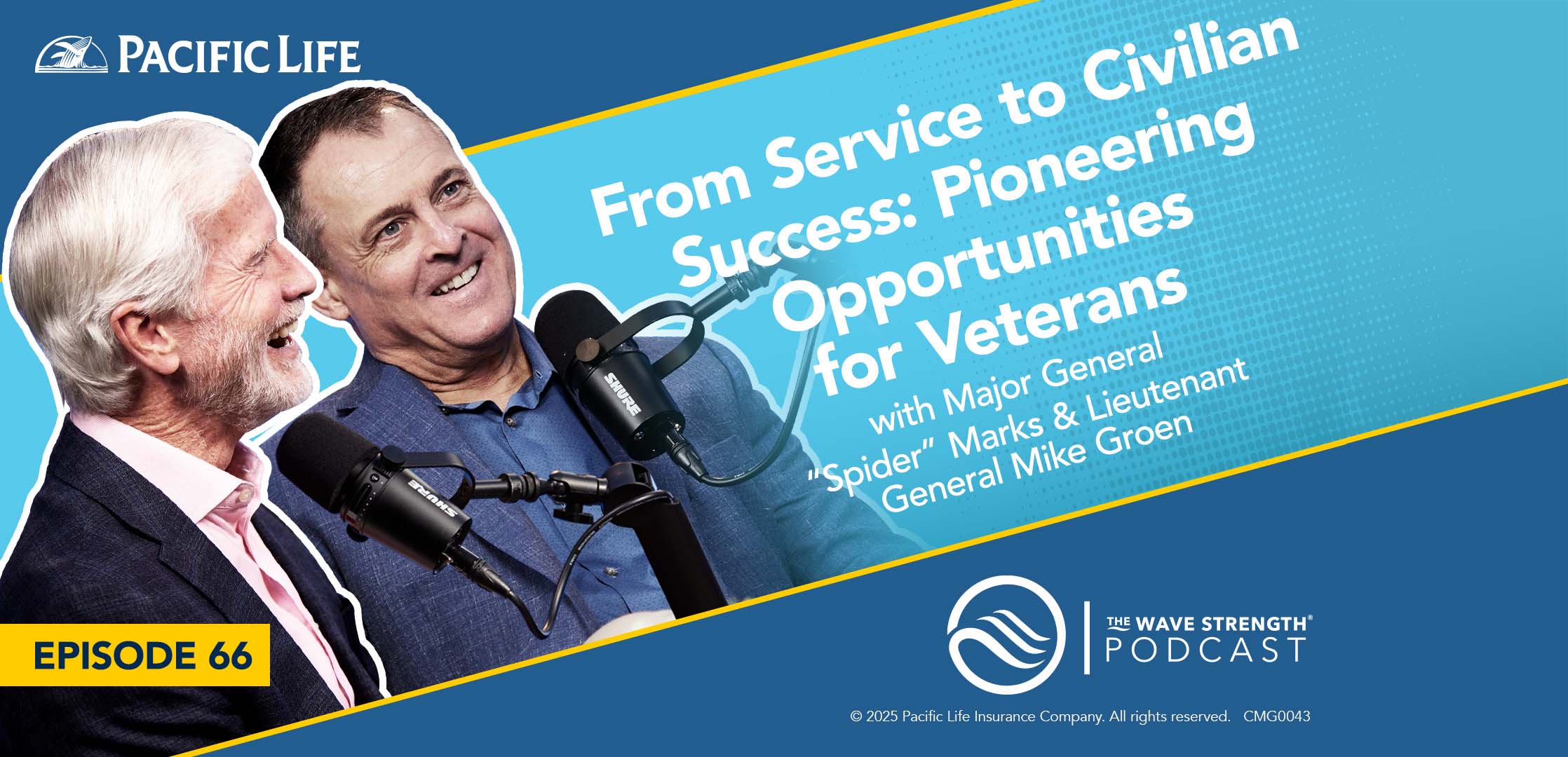
.jpg)
